- Advertising

Advertising Management
Advertising simply put is telling and selling the product. Advertising Management though is a complex process of employing various media to sell a product or service . This process begins quite early from the marketing research and encompasses the media campaigns that help sell the product.
Without an effective advertising management process in place, the media campaigns are not that fruitful and the whole marketing process goes for a toss. Hence, companies that believe in an effective advertising management process are always a step ahead in terms of selling their goods and services.
As mentioned above, advertising management begins from the market research phase. At this point, the data produced by marketing research is used to identify what types of advertising would be adequate for the specific product.
Gone are the days when there was only print and television advertising available to the manufacturers. These days apart from print and television, radio, mobile, and Internet are also available as advertising media. Advertising management process in fact helps in defining the outline of the media campaign and in deciding which type of advertising would be used before the launch of the product.
If you wish to make the advertising effective, always remember to include it from the market research time . Market research will help to identify the niche segment of the population to which the product or service has to be targeted from a large population. It will also identify why the niche segment would opt for the product or service. This information will serve as a guideline for the preparation of advertising campaigns.
Once the niche segments are identified and the determination of what types of advertising will be used is done, then the advertising management focuses on creating the specifics for the overall advertising campaign. If it is a radio campaign, which type of ads would be used, if it is a print campaign, what write ups and ads will be used, and if it is a television campaign, what type of commercials will be used.

There might also be a mix and match advertising in which radio might supplement television advertising and so on. It is important that through advertising management the image is conveyed that all the strategies complement each other. It should not look to public that the radio advertising is focusing on something else while television on something else. The whole process in the end should benefit the product or service.
The role of people designing the advertising campaign is crucial to its success. They have been trained by seasoned professionals who provide the training in the specific field. Designing an advertising campaign is no small a task and to understand the consumer behavior from the data collected from market research is a very important aspect of the campaign.
A whole lot of creativity and inspiration is required to launch an adequate advertising campaign. In addition, the management skills come into play when the work has to be done keeping the big picture in mind. It would be fruitful for the company if the advertising campaign lasts well over the lifetime of a product or service, reach the right customers, and generate the desired revenue .
Related Articles
- Classification of Advertising
- Print Advertising
- Broadcast Advertising
- Outdoor Advertising
- Covert & Public Serving Advertising
View All Articles
Authorship/Referencing - About the Author(s)
The article is Written By “Prachi Juneja” and Reviewed By Management Study Guide Content Team . MSG Content Team comprises experienced Faculty Member, Professionals and Subject Matter Experts. We are a ISO 2001:2015 Certified Education Provider . To Know more, click on About Us . The use of this material is free for learning and education purpose. Please reference authorship of content used, including link(s) to ManagementStudyGuide.com and the content page url.
- Advertising Management - Introduction
- Objectives & Importance of Advertising
- Marketing Communications
- Consumer Communication
- Consumer Behaviour
- Media Strategy in Advertising
- Advertising Agencies
- Social & Economic Aspects of Advertising
- Steps in Advertising Process
- Advertising Techniques
- Advertising Budget
- Advertising Campaigns
- Models of Advertising Scheduling
- Industrial Advertising
- Ethics in Advertising
- Measuring Advertising Effectiveness
- Advertising Myths
- Future of Advertising
- News Based Advertising: Ethical or Not!
- Ad Spending: A Primer
- The Rise of Digital Lynch Mobs and What They Mean for Businesses in Our 24/7 World
Design a Successful Advertisement Assignment: A Step-by-Step Guide
Define your advertisement objectives, identify your target audience, establish advertising goals, determine your unique selling proposition, create your advertisement concept, brainstorm ideas, choose the right ad format, develop visuals and copy, design your advertisement layout, apply layout principles, select a color scheme, choose typography, create your own advertisement assignment, utilize ad creation tools, test different ad versions, gather feedback, measure your advertisement success, identify key performance indicators, analyze results, optimize your ad campaign.
Designing a successful advertisement assignment doesn't have to be an intimidating task. In this step-by-step guide, we will walk you through the entire process to create your own advertisement assignment that will effectively reach your target audience and achieve your advertising goals. Let's dive in!
Before you start designing your ad, it's important to have a clear understanding of what you want to achieve with your advertisement assignment. This involves identifying your target audience, establishing advertising goals, and determining your unique selling proposition.
Knowing who you want to reach with your ad is essential for creating a successful campaign. Consider the following factors when identifying your target audience:
- Demographics: age, gender, location, income, etc.
- Interests: hobbies, preferences, needs, etc.
- Behavior: online habits, purchasing patterns, etc.
Having a clear idea of who your target audience is will help you tailor your ad to resonate with them and increase its effectiveness.
Setting goals for your advertisement assignment will help you measure its success and guide your design choices. Common advertising goals include:
- Increasing brand awareness
- Driving website traffic
- Generating leads or sales
- Encouraging customer engagement
Choose the goals that align with your overall marketing strategy and ensure they are specific, measurable, achievable, relevant, and time-bound (SMART).
Your unique selling proposition (USP) is what sets your product or service apart from your competitors. It's the reason why customers should choose you over other options. To determine your USP, consider:
- What makes your product or service unique
- The benefits your customers will receive
- How your product or service solves a problem or fulfills a need
Once you've identified your USP, make sure to emphasize it in your advertisement assignment to effectively communicate your value proposition to your target audience.
Now that you've defined your objectives, it's time to get creative! In this section, we'll explore how to brainstorm ideas, choose the right ad format, and develop engaging visuals and copy to create an advertisement concept that captures your target audience's attention and achieves your goals.
Before diving into ad design, take some time to brainstorm ideas for your advertisement assignment. Here are some tips to help you get started:
- Think about your target audience's interests and preferences. What type of content would they find appealing?
- Consider your unique selling proposition (USP) and how it can be incorporated into the ad concept.
- Try using mind mapping or free-writing techniques to generate a list of ideas.
- Take inspiration from successful ads in your industry, but remember to put your own spin on it and stay true to your brand.
Don't be afraid to think outside the box—sometimes, the most memorable ads are the ones that break the mold!
There are various ad formats available, each with its own strengths and limitations. When choosing the right format for your advertisement assignment, consider the following:
- Print ads: These include newspapers, magazines, and billboards. They're ideal for reaching a local audience or targeting a specific demographic.
- Online ads: From display banners to social media ads, online advertising offers a wide range of options to reach your target audience on various platforms.
- Video ads: With the rise of platforms like YouTube, video ads are an engaging way to tell your story and showcase your product or service.
- Audio ads: Whether it's a traditional radio spot or a podcast ad, audio ads are a great way to reach people who are on the go or multitasking.
Consider the preferences of your target audience and the nature of your product or service when selecting the most suitable ad format for your campaign.
Once you've settled on an ad format, it's time to bring your advertisement concept to life with compelling visuals and copy. Here's what you need to keep in mind:
- Visuals: Choose images or graphics that are eye-catching and relevant to your product or service. Ensure they align with your brand identity and resonate with your target audience. Don't forget to consider the principles of design, such as contrast, balance, and hierarchy, to create a visually appealing ad.
- Copy: Write clear and concise copy that communicates your unique selling proposition and encourages your target audience to take action. Use persuasive language, but avoid over-hyping your product or service. Remember to include a strong call-to-action (CTA) that tells your audience what you want them to do next.
By combining well-designed visuals and engaging copy, you're well on your way to create your own advertisement assignment that stands out and achieves your advertising goals.
With your advertisement concept in place, it's time to focus on designing an attention-grabbing layout that will showcase your visuals and copy effectively. In this section, we'll discuss how to apply layout principles, select a color scheme, and choose typography to create your own advertisement assignment that stands out and engages your target audience.
To create a visually appealing and functional ad layout, you'll need to consider several design principles. These principles will help guide your design choices and ensure your ad effectively communicates your message:
- Balance: Distribute visual elements evenly across your ad to create a sense of harmony and stability. This can be achieved through symmetrical or asymmetrical layouts.
- Contrast: Use contrasting colors, shapes, and sizes to differentiate between elements and draw attention to key sections of your ad.
- Hierarchy: Organize your ad's elements in a way that guides the viewer's eye through the most important information first. This can be done by varying the size, color, or position of elements.
- Whitespace: Don't be afraid to leave some empty space in your layout. Whitespace can help your ad feel less cluttered and make it easier for the viewer to focus on your message.
By applying these layout principles, you'll be able to create a well-organized and visually striking advertisement that effectively communicates your message to your target audience.
Color plays a significant role in creating an eye-catching and memorable advertisement. When selecting a color scheme for your ad, consider the following:
- Brand consistency: Use colors that align with your brand identity to create a cohesive look and establish brand recognition.
- Emotional impact: Different colors can evoke different emotions in viewers. Choose colors that elicit the desired emotional response from your target audience.
- Contrast: As mentioned earlier, contrast is essential for drawing attention to specific elements in your ad. Make sure your color choices provide enough contrast to make your text and visuals stand out.
By carefully selecting a color scheme, you'll be able to create an advertisement assignment that not only looks visually appealing but also resonates with your audience on an emotional level.
Typography is another crucial aspect of your ad's overall design. The right font choices can greatly impact your ad's readability and aesthetic appeal. When selecting typography for your advertisement assignment, keep these tips in mind:
- Legibility: Choose fonts that are easy to read, especially for the most important information in your ad.
- Font pairing: Use a combination of complementary fonts to create a visually interesting and balanced design. Typically, this involves using one font for headlines and another for body copy.
- Consistency with your brand: Select fonts that are consistent with your brand's identity and messaging to maintain a cohesive look across all your marketing materials.
With the right typography choices, your ad will not only look visually appealing but also ensure that your message is easily understood by your audience.
Moving through these steps, you're well on your way to create your own advertisement assignment that stands out and communicates your message effectively. Remember, a well-designed ad is a powerful tool to engage your target audience and achieve your advertising goals.
Now that you've designed your advertisement layout, it's time to bring your concept to life and create your own advertisement assignment. In this section, we'll cover how to utilize ad creation tools, test different ad versions, and gather feedback to ensure that your advertisement is as effective as it can be. Let's dive in!
Creating your advertisement doesn't have to be a daunting task. Many tools are available that can help you bring your design to life, even if you're not a professional designer. Some popular options include:
- Canva: A user-friendly online design platform where you can create eye-catching ads using customizable templates, graphics, and fonts.
- Adobe Spark: Another online design tool that offers a variety of templates and design elements to help you create professional-looking ads.
- Google Web Designer: A free tool from Google that allows you to create HTML5 ads with animations and interactive elements.
By leveraging these tools, you'll be able to create your own advertisement assignment without having to worry about mastering advanced design skills.
Once you have your ad design, it's important to test different versions of your ad to determine which one performs best. This process, known as A/B testing, involves creating two or more variations of your ad and measuring their performance based on key metrics. To conduct an effective A/B test, consider the following tips:
- Test one element at a time, such as headlines, images, or calls to action, to identify which specific changes lead to better results.
- Run your tests for a sufficient amount of time and ensure that you have enough data to make informed decisions.
- Analyze your test results and implement changes based on your findings. Remember, the goal is to continuously improve your ad's performance.
This process of testing different ad versions will help you optimize your advertisement assignment and maximize its effectiveness.
Finally, don't forget to gather feedback from your target audience. It's essential to understand how your ad is being received and if it's resonating with your audience. Here are some ways to gather valuable feedback:
- Focus groups: Organize a group of people from your target audience and show them your ad. Encourage them to share their thoughts and opinions on its effectiveness, design, and messaging.
- Surveys: Distribute surveys to your target audience asking for their opinions on your ad. This can provide you with quantitative data and specific insights to help you make improvements.
- Social media: Share your ad on social media platforms and monitor comments and reactions. This can give you a real-time understanding of how your audience is responding to your ad.
By gathering feedback from your audience, you'll have a better understanding of what works and what doesn't, allowing you to refine your advertisement assignment and make it even more effective.
With these steps, you're well-equipped to create your own advertisement assignment that stands out and captivates your target audience. Remember, the key to a successful ad is continuous improvement, so don't be afraid to test, gather feedback, and make adjustments as needed. Good luck on your advertising journey!
After creating your own advertisement assignment, the next step is to measure its success. Analyzing your ad's performance will help you understand what's working, what's not, and how you can improve your advertising strategy. In this section, we'll discuss how to identify key performance indicators (KPIs), analyze results, and optimize your ad campaign. So, let's get started!
Key performance indicators (KPIs) are measurable values that help you determine whether your advertisement is on track to achieve its goals. To effectively measure your ad's success, you'll need to identify the most relevant KPIs for your advertising objectives. Some common KPIs include:
- Click-through rate (CTR): The percentage of people who click on your ad after seeing it. A higher CTR indicates that your ad is resonating with your audience and driving them to take action.
- Conversion rate: The percentage of users who complete a desired action after clicking on your ad, such as making a purchase or signing up for a newsletter. This metric helps you understand how effective your ad is at encouraging users to take action.
- Return on ad spend (ROAS): The revenue generated from your ad campaign divided by the amount you've spent on it. This KPI helps you determine whether your advertising investment is paying off.
By focusing on the right KPIs, you'll be able to accurately measure the success of your advertisement assignment and make data-driven decisions to improve its performance.
Once you've identified your KPIs, it's time to analyze the results of your ad campaign. Regularly monitoring your ad's performance will help you spot trends, identify areas for improvement, and make informed decisions about your advertising strategy. Here are a few tips for effective analysis:
- Track your KPIs: Use advertising platforms like Google Ads or Facebook Ads Manager to monitor your KPIs and gather data about your ad's performance.
- Compare results: Look at how your ad is performing compared to previous campaigns or industry benchmarks. This will help you understand whether your ad is meeting or exceeding expectations.
- Identify patterns: Look for trends in your data, such as certain days of the week or times of day when your ad performs better. This information can help you optimize your ad schedule for maximum impact.
By analyzing your ad's results, you'll gain valuable insights into its performance and be better equipped to create your own advertisement assignment that drives success.
Now that you've analyzed the results of your ad campaign, it's time to optimize it for even better performance. Optimization involves making adjustments to your ad based on your findings to improve its effectiveness. Here are some ways to optimize your ad campaign:
- Refine your targeting: If your ad isn't resonating with your target audience, consider adjusting your audience targeting to better reach potential customers who are more likely to be interested in your product or service.
- Test different ad elements: As discussed earlier, A/B testing different versions of your ad can help you identify what works best and improve your ad's performance. Keep testing and iterating to find the most effective combination of visuals, copy, and calls to action.
- Adjust your ad budget: If you find that your ad is performing well, consider increasing your budget to reach more potential customers. Conversely, if your ad is underperforming, you may need to reevaluate your budget and allocate resources more effectively.
Optimizing your ad campaign is an ongoing process that requires regular analysis and adjustments. By doing so, you'll continue to improve your ad's performance and make your advertisement assignment even more successful.
In conclusion, measuring your advertisement's success is a crucial part of the advertising process. By identifying the right KPIs, analyzing your results, and optimizing your ad campaign, you'll be well on your way to creating your own advertisement assignment that achieves your desired goals. Remember, advertising is an iterative process, so keep learning, experimenting, and improving to ensure your ads reach their full potential. Happy advertising!
If you're looking to further enhance your advertising skills after reading our step-by-step guide, don't miss the workshop ' What Makes a Memorable Advertisement? ' by Jessy Moussallem. This workshop will provide you with valuable insights on creating impactful and unforgettable advertisements that will resonate with your target audience.

Live classes every day
Learn from industry-leading creators
Get useful feedback from experts and peers
Best deal of the year
* billed annually after the trial ends.
*Billed monthly after the trial ends.
Advertising Management: A Comprehensive Guide
Advertising management is an indispensable part of any modern business. In fact, 68% of marketers consider it extremely important for their overall marketing strategy. Business competition is high, and the race for customers is even higher, so you must find ways to stand out. With proper advertising, you can craft meaningful messages that will speak to your audience, popularize your brand, and warm up your prospecting efforts. In fact, you probably can recall at least one ad that made you buy something or at least remember the brand. For B2C customers, that could be that funny Fiat commercial that worked solely on creativity and did its job perfectly. In B2B, however, besides creativity, you have to have precision.
Your digital ad messaging should feel as personally crafted as possible, target the right people, and be delivered at the right time. Tracking consumer behavior should be the path to engaging your prospects during their buyer’s journey . However, it’s not an easy process to handle, especially if you are new to ad management. Let’s discover its definition, types, objectives, and benefits for your business.

What Is Advertising Management?
Advertising management is the process to plan, oversee, and control various advertising activities meant to influence the target audiences’ buying decisions . Simply put, the role of advertising management is to develop and place the ads in the most relevant places that will bring the best results. The scope of ad management includes analyzing the current advertising strategy and target audience , evaluating its effectiveness, and updating it toward existing goals. It also involves setting the budget, crafting relevant messaging, hiring relevant specialists, and managing their work.
Implementing strategic advertising management practices into your business plan is meant to introduce certain products or services to your relevant audience, develop a better image, level-up brand awareness, and boost overall sales. Some people try to handle these processes themselves while others hire professional digital agencies .

Types of Digital Advertising Management
Although there are many types of advertising management—from print to broadcast media—digital advertising has gained significant traction with B2B marketers. In fact, the U.S. digital ad market is expected to exceed $300 billion by 2025.
Digital advertising management involves placing ads on online channels to promote your brand, product, or service. There is a big variety of digital formats you can use for your business, including emails, social media, blogs, search engines, and forums — and all of which can host your ads.
Let’s look at the main types of digital advertising management to determine the best format for your business:
Social media advertising
Social media advertising presents its ads on various social media platforms (Instagram, Facebook, YouTube, etc.) and is popular due to the number of users and easy implementation into the marketing strategy. Social media ads can be targeted, sponsored, and organic (influencers and word of mouth). Some social media automation tools even allow you to boost your post directly from their dashboard.
Search engine advertising
Search engine ads appear during web searches and have two common forms: search engine optimization (SEO) and pay-per-click (PPC) ads. SEO and link building activities are responsible for promoting your content in search engines (blogs and web pages) based on certain keywords.
PPC allows businesses to pay and appear on top of suggested results. Since most of the readers end up on the first page of Google, this strategy is worth pursuing.
Interactive advertising
Interactive advertising includes video ads and online ads that require viewers to perform a certain action. Although interactive ads take more time to produce, they also show good response levels and appear among current lead generation trends .
This type of advertising has unlimited creativity options and has an opportunity to engage the prospect emotionally.
Email advertising
Although email advertising has been pushed to the limits of SPAM in the past, it is still one of the most popular and effective ways to reach an audience. The key here is to include the people you have communicated with your company before or opted-in on your website. It’s affordable and can be used to promote specific offers or introduce new services.
Programmatic display advertising
Programmatic ads deliver a promotional message across various communication channels. They can be presented as banners, landing pages, or pop-up ads and can appear anywhere on the Internet.
Digital ads have a high-speed delivery and offer further segmentation of your lead lists . They can be altered, personalized, and changed as your campaign progresses, always striving for maximum effectiveness. But most importantly, they can combine all of the previously mentioned advertising types into one thorough ad campaign. CIENCE offers a GO Digital solution that analyzes your ideal customer profile (ICP) and differentiates micro audiences from it to create a highly targeted ad campaign. Ads like those can appear to the prospects in your lead list prior to the first contact with a sales development representative ( SDR ), warming up the cold outreach and raising overall brand awareness .

3 Main Advertising Management Objectives
The goal of any promotion should be to carry out conversations between the brand and the customer to increase sales and profits, but there’s a bit more to it. Before starting a campaign, determine your advertising management objectives:
1. To introduce
The first advertising objective is to inform your potential customers about your brand. Make them aware of the services you provide, introduce a new product or present an interesting offer, or talk about breaking into a new market . All of these will serve as a conversation starter around your brand and can lay the groundwork for the next objective.
2. To persuade
Another goal is to convince your potential buyers that your product or service is the best. This objective is meant to show your value over the competitors and persuade them to switch brands. Every ad should have a clear purpose and call to action (CTA) that needs to be performed, such as clicking a link or filling out a form.
3. To remind

Questions to Ask in Ad Management
To choose the right direction in the advertising management process, you have to ask some questions to determine your advertising path. Here are some top questions to consider:
What role does advertising play in overall marketing?
Think of it as the rough number of leads, customers, email opens, clicks, or any other rates you get (or expect to get) from the advertising efforts. And then compare it to the overall numbers from your marketing. This way, you can see how effective advertising is for your business and decide if you need to enhance it or maybe slow it down a bit.
Why do you need to advertise?
Do you need to break into a new market? Do you want your services to have a wider reach? Or is there a seasonal offer you’d like to present? Answers to these questions will give you an understanding of what you want to achieve and what the strategy (messaging, timing, execution) will be to do so.
Go back to those three main objectives to determine your area of focus.
How will you achieve set goals?
This is where you actually plan the future advertising management strategy: Check out the competition , look for ideas, consult with the team, and maybe do a little test run.
Who will be responsible for coordinating advertising efforts?
Whether you’re gathering the team from the ground up or assembling help from your marketing department, you’ll need designers, content writers, marketing specialists, and managers for your advertising management efforts.
When will you kick off certain elements of the advertising campaign?
It’s important to set the terms: How much time does your team have to prepare the vital elements? When is the campaign rolling out? And when should you expect the first results?

Advertising Management Process
So what is the scope of your marketing advertising management? How do you manage ads? Let’s go through the main steps to create a strategic process:
1. Review the marketing plan.
Advertising objectives come out of the marketing objectives , so it makes sense to review the whole marketing plan before starting an advertising campaign. This ensures that any promotional activity that takes place will align with your company’s vision and values. At this point, perform an audit of your marketing plan:
- Research competitors and markets.
- Evaluate what has proven to be effective in the past.
- Assess budget restrictions.
- Analyze the target market and audience.
2. Create an advertising framework.
Objectives of advertising management provide the framework for the entire advertising strategy. Specify the goals you need to achieve and how to evaluate them. For consistent performance, you can choose one of these top marketing models: AIDA , SMART, or DAGMAR. To set realistic objectives, you should consider the needs for your service:
- Brand awareness: brand recognition and brand recall
- Brand preference: whether you get preferred over your competitors
- Purchase intent: probability the consumer will buy your product
- Purchase facilitation: whether a client knows where and how to make a purchase.
3. Establish the budget.
An advertising management budget is only a subset of a marketing budget, which is a subset of a general budget. However, in 2021 , U.S. Facebook ad spending alone was estimated at $50.30 billion. But thanks to modern digital advertising, it doesn't have to cost billions for you. To outline a reasonable budget, your sales advertising management team should calculate how important advertising is to sales (percentage of how many converted leads came from ads), calculate the costs of media channels used, and add hiring costs, salaries, tech stack , etc.
4. Determine media channels.
Once you set the objectives and budget, advertising management can plan out the next steps that need to be taken throughout the ad journey. This includes media channel strategy development, media tactics design, and effectiveness evaluation. Start by answering the following questions:
- Where would the ad be placed?
- How many times would a target audience member see the ad in a given period?
- How wide is the reach of the ad?
- What level of ad exposure is needed to reach the goals?

Importance of Advertising Management
According to Hubspot , at least 33% of marketers use advertising to boost brand awareness . But the importance of advertising management doesn’t stop there. Here are some other ways that advertising—and specifically digital ads—can be advantageous to your business:
1. Introduces your name to the public
Advertising management helps bring and introduce new business solutions to the market. In addition to boosting brand awareness, it gives you a platform to show your advantages over the competitors, and it also opens up brand-new markets for your business.
2. Keeps advertising under control
Without supervision, there’s a lot that can go wrong in any marketing activity. Having an advertising management process helps to guide your strategies in the right direction, check for updates and new approaches, and find the best (and most cost-effective) ways to reach the right audience with the right message.
3. Enhances sales
Almost every business activity has the end goal of contributing to sales. Advertising may not result in many direct sales; however, it’s an important step in omnichannel outreach that warms up the leads, spreads the word about your services, and contributes to the overall success of sales.
4. Precise targeting
You need to be able to target the right prospects who would be interested in your services, and thanks to SEO, website visitor tracking , and targeted ads, that’s what digital advertising allows you to do.
5. Cost-effective
Print, TV, or outdoor ads cost a lot, and not all companies can afford that. With reasonable prices in digital advertising, everyone gets to start on the approximately same level, save some money, and then let management do its job.
6. Measurable results
Traditional advertising can be hard to measure due to being offline, while in digital, there are plenty of KPIs to check the results of the efforts put in: conversion rate , traffic, unique visitors, click-through rate, etc.
Manage Your Ads the Right Way
From awareness to purchase in the buyers' journey, ads can warm up the leads , introduce your brand to the target audience, open new markets, build your brand , and eventually, enhance sales . However, to get the most out of your advertising efforts, you should invest in advertising management. Ad management is the strategic thinking behind advertising that is responsible for setting objectives to define the right marketing direction, pick the outreach channels, and take all of the necessary steps to reach your desired goals.

A Few (Related) Sales Posts

CIENCE Honored by Comparably as a Top Company for Women and Diversity 2022

Comparably Names CIENCE One of the Best Companies for Career Growth

CIENCE Technologies Appoints Eric Quanstrom as Chief Marketing Officer
Let’s get you scheduled with our sales team now — just pick a date and time for a call!
- CRM Asignment Help
- MBA Assignment Help
- Statistics Assignment Help
- Market Analysis Assignment Help
- Business Development Assignment Help
- 4p of Marketing Assignment Help
- Pricing Strategy Assignment Help
- Operations Management Assignment Help
- Corporate Strategy Assignment Help
- Change Management Assignment Help
- Supply Chain Management Assignment Help
- Human Resource Assignment Help
- Management Assignment Help
- Marketing Assignment Help
- Strategy Assignment Help
- Operation Assignment Help
- Marketing Research Assignment Help
- Strategic Marketing Assignment Help
- Project Management Assignment Help
- Strategic Management Assignment Help
- Marketing Management Assignment Help
- Business Assignment Help
- Business Ethics Assignment Help
- Consumer Behavior Assignment Help
- Conflict Management Assignment Help
- Business Statistics Assignment Help
- Managerial Economics Assignment Help
- Project Risk Management Assignment Help
- Nursing Assignment Help
- Clinical Reasoning Cycle
- Nursing Resume Writing
- Medical Assignment Help
- Financial Accounting Assignment Help
- Financial Services Assignment Help
- Finance Planning Assignment Help
- Finance Assignment Help
- Forex Assignment Help
- Behavioral Finance Assignment Help
- Personal Finance Assignment Help
- Capital Budgeting Assignment Help
- Corporate Finance Planning Assignment Help
- Financial Statement Analysis Assignment Help
- Accounting Assignment Help
- Solve My Accounting Paper
- Taxation Assignment Help
- Cost Accounting Assignment Help
- Managerial Accounting Assignment Help
- Business Accounting Assignment Help
- Activity-Based Accounting Assignment Help
- Economics Assignment Help
- Microeconomics Assignment Help
- Econometrics Assignment Help
- IT Management Assignment Help
- Robotics Assignment Help
- Business Intelligence Assignment Help
- Information Technology Assignment Help
- Database Assignment Help
- Data Mining Assignment Help
- Data Structure Assignment Help
- Computer Network Assignment Help
- Operating System Assignment Help
- Data Flow Diagram Assignment Help
- UML Diagram Assignment Help
- Solidworks Assignment Help
- Cookery Assignment Help
- R Studio Assignment Help
- Law Assignment Help
- Law Assignment Sample
- Criminology Assignment Help
- Taxation Law Assignment Help
- Constitutional Law Assignment Help
- Business Law Assignment Help
- Consumer Law Assignment Help
- Employment Law Assignment Help
- Commercial Law Assignment Help
- Criminal Law Assignment Help
- Environmental Law Assignment Help
- Contract Law Assignment Help
- Company Law Assignment Help
- Corp. Governance Law Assignment Help
- Science Assignment Help
- Physics Assignment Help
- Chemistry Assignment Help
- Sports Science Assignment Help
- Chemical Engineering Assignment Help
- Biology Assignment Help
- Bioinformatics Assignment Help
- Biochemistry Assignment Help
- Biotechnology Assignment Help
- Anthropology Assignment Help
- Paleontology Assignment Help
- Engineering Assignment Help
- Autocad Assignment Help
- Mechanical Assignment Help
- Fluid Mechanics Assignment Help
- Civil Engineering Assignment Help
- Electrical Engineering Assignment Help
- Ansys Assignment Help
- Humanities Assignment Help
- Sociology Assignment Help
- Philosophy Assignment Help
- English Assignment Help
- Geography Assignment Help
- History Assignment Help
- Agroecology Assignment Help
- Psychology Assignment Help
- Social Science Assignment Help
- Public Relations Assignment Help
- Political Science Assignment Help
- Mass Communication Assignment Help
- Auditing Assignment Help
- Dissertation Writing Help
- Sociology Dissertation Help
- Marketing Dissertation Help
- Biology Dissertation Help
- Nursing Dissertation Help
- MATLAB Dissertation Help
- Law Dissertation Help
- Geography Dissertation Help
- English Dissertation Help
- Architecture Dissertation Help
- Doctoral Dissertation Help
- Dissertation Statistics Help
- Academic Dissertation Help
- Cheap Dissertation Help
- Dissertation Help Online
- Dissertation Proofreading Services
- Do My Dissertation
- Business Report Writing
- Programming Assignment Help
- Java Programming Assignment Help
- C Programming Assignment Help
- PHP Assignment Help
- Python Assignment Help
- Perl Assignment Help
- SAS Assignment Help
- Web Designing Assignment Help
- Android App Assignment Help
- JavaScript Assignment Help
- Linux Assignment Help
- Mathematics Assignment Help
- Geometry Assignment Help
- Arithmetic Assignment Help
- Trigonometry Assignment Help
- Calculus Assignment Help
- Arts Architecture Assignment Help
- Arts Assignment Help
- Case Study Assignment Help
- History Case Study
- Case Study Writing Services
- Write My Case Study For Me
- Business Law Case Study
- Civil Law Case Study Help
- Marketing Case Study Help
- Nursing Case Study Help
- ZARA Case Study
- Amazon Case Study
- Apple Case Study
- Coursework Assignment Help
- Finance Coursework Help
- Coursework Writing Services
- Marketing Coursework Help
- Maths Coursework Help
- Chemistry Coursework Help
- English Coursework Help
- Do My Coursework
- Custom Coursework Writing Service
- Thesis Writing Help
- Thesis Help Online
- Write my thesis for me
- CDR Writing Services
- CDR Engineers Australia
- CDR Report Writers
- Homework help
- Algebra Homework Help
- Psychology Homework Help
- Statistics Homework Help
- English Homework Help
- CPM homework help
- Do My Homework For Me
- Online Exam Help
- Pay Someone to Do My Homework
- Do My Math Homework
- Macroeconomics Homework Help
- Jiskha Homework Help
- Research Paper Help
- Edit my paper
- Research Paper Writing Service
- Write My Paper For Me
- Buy Term Papers Online
- Buy College Papers
- Paper Writing Services
- Research Proposal Help
- Proofread My Paper
- Report Writing Help
- Story Writing Help
- Grant Writing Help
- DCU Assignment Cover Sheet Help Ireland
- CHCDIV001 Assessment Answers
- BSBWOR203 Assessment Answers
- CHC33015 Assessment Answers
- CHCCCS015 Assessment Answers
- CHCECE018 Assessment Answers
- CHCLEG001 Assessment Answers
- CHCPRP001 Assessment Answers
- CHCPRT001 Assessment Answers
- HLTAAP001 Assessment Answers
- HLTINF001 Assessment Answers
- HLTWHS001 Assessment Answers
- SITXCOM005 Assessment Answers
- SITXFSA001 Assessment Answers
- BSBMED301 Assessment Answers
- BSBWOR502 Assessment Answers
- CHCAGE001 Assessment Answers
- CHCCCS011 Assessment Answers
- CHCCOM003 Assessment Answers
- CHCCOM005 Assessment Answers
- CHCDIV002 Assessment Answers
- CHCECE001 Assessment Answers
- CHCECE017 Assessment Answers
- CHCECE023 Assessment Answers
- CHCPRP003 Assessment Answers
- HLTWHS003 Assessment Answers
- SITXWHS001 Assessment Answers
- BSBCMM401 Assessment Answers
- BSBDIV501 Assessment Answers
- BSBSUS401 Assessment Answers
- BSBWOR501 Assessment Answers
- CHCAGE005 Assessment Answers
- CHCDIS002 Assessment Answers
- CHCECE002 Assessment Answers
- CHCECE007 Assessment Answers
- CHCECE025 Assessment Answers
- CHCECE026 Assessment Answers
- CHCLEG003 Assessment Answers
- HLTAID003 Assessment Answers
- SITXHRM002 Assessment Answers
- Elevator Speech
- Maid Of Honor Speech
- Problem Solutions Speech
- Award Presentation Speech
- Tropicana Speech Topics
- Write My Assignment
- Personal Statement Writing
- Narrative Writing help
- Academic Writing Service
- Resume Writing Services
- Assignment Writing Tips
- Writing Assignment for University
- Custom Assignment Writing Service
- Assignment Provider
- Assignment Assistance
- Solve My Assignment
- Pay For Assignment Help
- Assignment Help Online
- HND Assignment Help
- SPSS Assignment Help
- Buy Assignments Online
- Assignment Paper Help
- Assignment Cover Page
- Urgent Assignment Help
- Perdisco Assignment Help
- Make My Assignment
- College Assignment Help
- Get Assignment Help
- Cheap Assignment Help
- Assignment Help Tutors
- TAFE Assignment Help
- Study Help Online
- Do My Assignment
- Do Assignment For Me
- My Assignment Help
- All Assignment Help
- Academic Assignment Help
- Student Assignment Help
- University Assignment Help
- Instant Assignment Help
- Powerpoint Presentation Service
- Last Minute Assignment Help
- World No 1 Assignment Help Company
- Mentorship Assignment Help
- Legit Essay
- Essay Writing Services
- Essay Outline Help
- Descriptive Essay Help
- History Essay Help
- Research Essay Help
- English Essay Writing
- Literature Essay Help
- Essay Writer for Australia
- Online Custom Essay Help
- Essay Writing Help
- Custom Essay Help
- Essay Help Online
- Writing Essay Papers
- Essay Homework Help
- Professional Essay Writer
- Illustration Essay Help
- Scholarship Essay Help
- Need Help Writing Essay
- Plagiarism Free Essays
- Write My Essay
- Response Essay Writing Help
- Essay Assistance
- Essay Typer
- APA Reference Generator
- Harvard Reference Generator
- Vancouver Reference Generator
- Oscola Referencing Generator
- Deakin Referencing Generator
- Griffith Referencing Tool
- Turabian Citation Generator
- UTS Referencing Generator
- Swinburne Referencing Tool
- AGLC Referencing Generator
- AMA Referencing Generator
- MLA Referencing Generator
- CSE Citation Generator
- ASA Referencing
- Oxford Referencing Generator
- LaTrobe Referencing Tool
- ACS Citation Generator
- APSA Citation Generator
- Central Queensland University
- Holmes Institute
- Monash University
- Torrens University
- Victoria University
- Federation University
- Griffith University
- Deakin University
- Murdoch University
- The University of Sydney
- The London College
- Ulster University
- University of derby
- University of West London
- Bath Spa University
- University of Warwick
- Newcastle University
- Anglia Ruskin University
- University of Northampton
- The University of Manchester
- University of Michigan
- University of Chicago
- University of Pennsylvania
- Cornell University
- Georgia Institute of Technology
- National University
- University of Florida
- University of Minnesota
- Help University
- INTI International University
- Universiti Sains Malaysia
- Universiti Teknologi Malaysia
- University of Malaya
- ERC Institute
- Nanyang Technological University
- Singapore Institute of Management
- Singapore Institute of Technology
- United Kingdom
- Jobs near Deakin University
- Jobs Near CQUniversity
- Jobs Near La Trobe University
- Jobs Near Monash University
- Jobs Near Torrens University
- Jobs Near Cornell University
- Jobs Near National University
- Jobs Near University of Chicago
- Jobs Near University of Florida
- Jobs Near University of Michigan
- Jobs Near Bath Spa University
- Jobs Near Coventry University
- Jobs Near Newcastle University
- Jobs Near University of Bolton
- Jobs Near university of derby
- Search Assignments
- Connect Seniors
- Essay Rewriter
- Knowledge Series
- Conclusion Generator
- GPA Calculator
- Factoring Calculator
- Plagiarism Checker
- Word Page Counter
- Paraphrasing Tool
- Living Calculator
- Quadratic Equation
- Algebra Calculator
- Integral Calculator
- Chemical Balancer
- Equation Solver
- Fraction Calculator
- Slope Calculator
- Fisher Equation
- Summary Generator
- Essay Topic Generator
- Alphabetizer
- Case Converter
- Antiderivative Calculator
- Kinematics Calculator
- Truth Table Generator
- Financial Calculator
- Reflection calculator
- Projectile Motion Calculator
- Paper Checker
- Inverse Function Calculator

Advertising Management Assignment of Virgin Airlines
Task: An effective advertising strategy requires an understanding of consumer insights. In order to gain consumer insights, students will develop skills related to designing and undertaking in-depth interviews, and collecting, analysing and interpreting qualitative data.
Graham (2010, p. 146) notes: The old adage says, “Consumers don’t buy features; consumers buy benefits.” Some researchers maintain that this is not the end of the story - that benefits are frequently not an end in themselves, but merely a means to achieving some valued end state (e.g., self-esteem, social belonging, etc.) that is important to the consumer. In other words, we might rewrite the adage to read: “Consumers buy features (attributes) that bring them benefits (consequences) that get them closer to a valued end state (values).”
The major goal of the interview is to examine how people make choices between brands, what attributes are important, and what benefit(s) and/or value(s) they receive from buying the product. The laddering technique is one way to explore the associations among attributes, consequences, and values. It is important to note that you need to use the laddering technique to prompt the consumer to tell you key attributes, benefits, and values. The laddering technique will be discussed in lecture and tutorial sessions.
Each student is to conduct several semi-structured interviews (about 30-45 minutes) on a product category (and brand) with people (2-4 adults) of their choice (e.g., friends, co-workers, or family members). Students are to prepare the interview questions (self- prepared) in advance. Students need to provide their respondents with a participant information sheet and a consent form for them to sign prior to participating once, they understand requirements.
During the interview, it is important that students take notes. Don’t write down everything; just jot down important information. An audio-recording is useful as it enables students to listen back to the whole interview, especially when the notes are not clear enough for analysis. Participants need to be informed of this (audio recording) prior to taking part. Upon interview completion, students should analyse the self-prepared interview questions and how three major components - attributes, consequences, and values - are associated (Reynolds & Gutman, 1988). Students are to then write up a report for submission of the assessment. Students also need to submit the signed interview consent forms with their final report.
Executive summary/abstract The emphasis has placed in this study of advertising management assignment connecting with the idea of advertisement management of the company Virgin Airlines. Communication guide and engagement follows the idea of systematic assistance so that the company can able to generate its corrective implementation procedure. Moreover, the effective communication technique follows the coordinated service assistance based on the long term work engagement and follow-up. The appropriate service engagement and concentrating on the interview procedure state the future approaches that correctively access the future planning pathway. The interview procedure helps to find the particular information that constructs the idea related to advertisement management. The advertisement management process needs the appropriate system for decision making so that the corrective work planning for the future assessment can able to structure.
Introduction In this advertising management assignment, we will be focusing on the Virgin Airline and its advertising management concentrating on perpetual mapping, consumer insight analysis, and ad analysis. Advertising is an effective way of communication and it manages the variety of services of the Virgin Company. Connecting with the customers and applying the best methods helps to generate the idea of systematic work association. The objective of this research is to find the best way of advertising technique so that Virgin Airline can generate its growth and development. The scope of the report is managing the advertisement prospect by engaging with the correct customers from the market. The importance of the research follows the idea of service convenience to the customers that engage effectively with organizational development.

Method The in-depth interview has arranged in this segment to generate the major idea concentrating on the future scope of the organization. The pre-scheduled and self-prepared interview will help to take out some of the informative information so that the proper pathway and information involvement can able to construct in this aspect. The data collection procedure will focus on the primary research technique so that the overall information can support future information prospect (Nolet et al. 2015). The face to face interview will generate the idea about creating and structuring the appropriate advertising management prospect for the Virgin Airline. The interviewee is 25 years old and connecting with the interview prospect by taking data from the crew members of the airlines' sector. The appropriate knowledge related to the advertising management and follows the useful criteria based on future planning and implementation pathway has been structured in this segment.
Analysis Converted the raw interview data into ladders The raw material needs to be constructed in a better manner so that further investigation can able to generate systematically. Concentrating and applying proper knowledge and take out the information which is necessary for the research can generate a better idea about the entire aspect (Morrison and Fakih, 2017). The management-related various factors along with the members' views have also stated in this aspect. During this interview, the psychological aspects also need to follow so that the standard information assistance and management pathway can able to generate in this aspect as well. The handful of information needs to strategically consider so that the applicable work prospect while managing the future information can process adequately.
A set of summary codes The summery codes and the further evaluation concentrates on the idea of the in-depth, individual interview so that it can support the corrective information based on consequences, attributes, and values. Concentrating on the applicable values and generating the supportive information segment follows the idea of the service segment and different managerial practices that the Virgin Airline has considered. The directive work planning structure and follows the area of segmentation helps to coordinate with the entire aspect that builds the measurement and customer value related perception as well. The directive work planning and engaging with the systematic information follow-up correlates with prior knowledge about the services that help to state the further information channeling segment (Morrison and Fakih, 2017). The applicable possibilities and medium of the organization can also provide major idea about this segment.
Created a hierarchical value map The hierarchical value map provided in this advertising management assignment concentrates on the idea of a means-end analysis prospect that generates the connection between the market needs and the brand attribute. Focusing on the various attributes of Virgin Airlines that considers the idea of systematic work approaches has concentrated on the overall market need in this segment. The directive work planning and understanding the idea of long term systematic assessment can create structured work planning assessment (Osotio et al. 2015). The value-based acknowledgment consists of the idea of long term work based planning so that the applicable system analysis can able to structure further information as well.
Address key findings The interview process has helped to provide some informative discussion and a good statement. The information has considered the application framework to build the necessary adjustment with the idea of creating the outcome from the overall process. The informative statement in this process connects with- ‘The price range of ozone depends upon the socioeconomic status of the passenger decides to travel’
Virgin Airlines is one of the most cleaned airlines. ‘The baby-friendly cabin crew help is keeping the situation under control’
‘Customers can also send their messages through comments or queries through E-mail. The support team of Virgin airlines is also available on Twitter’
‘Nowadays, every second person wants to have a social status in-crowd’
‘People who love having luxurious trips and the people belonging to the economy class both can travel with Virgin Airlines’
What is the function of Consumer insight in this advertising management assignment? The insight has proposed the idea of following appropriate service integration based on the preferences of the customers. The corrective work planning management to generate the different entertainment-based options like TV shows, music, blockbuster movies and massive library (Kelley et al. 2015). For the kids, the arrangement is also effective and the baby-friendly cabin provides suitable service as well.
The insight is quite good as customer management can provide major help in generating the brand value and brand awareness for the other customers. Constructing and managing the effective approaches consists of the idea of creating a suitable association based on the long term service processing and integration (Frennea et al. 2015).
The meaningful insight has been stated the understanding of-
The shocking statement in this segment is the information that connects with the social status of the consumer so they afford the high-class flight for them.
Offer values concentrate on the cleanliness and managing the supportive service engagement based on the future service-based association systematically. The directive planning and integration also take any kind of customer quarry and focuses on the review of them as well (Patterson et al. 2017). The sustainable program also helps to generate a major idea based on the corrective work process and involvement.
The actionable approach will generate from the segment of pre and post service based advertisement so that the Airline can able to generate its market effectiveness.
Managerial implications Based on the consumer insights and key findings from the interviews depicted in this advertising management assignment, it can be said that the target of the advertising campaign will be the airliner travellers. The target will include not only the travellers who travel for spending holidays or leisure but also the ones travelling for business purposes. The positioning strategy that can be used for the campaign is quality positioning. The interviews have helped to know that Virgin Airlines holds a number of advantages in terms of quality of service, costs and performance. The quality positioning will cause the target population to know about the quality of services and performance provided by Virgin Airlines. Thus, in order to position the superior advantages and communicate them to the target population, the quality position strategy is considered to be suitable. The advertising campaign needs to be directed as B2C (Brand to Customers) (Parviainen et al. 2017). Since, the present day world is greatly inclined towards the use of social media tools such as Facebook and Instagram, the best way to promote the advertising campaign is social media. Social media will assist to reach the advertisements to a large portion of the target population. Besides digital media strategy, the advertisements can also be broadcasted in radios and televisions (Parviainen et al. 2017).
It has been found that the other competitive brands of airlines such as Qantas and Tiger Air have focused on the attributes of comfortable seating and benefits respectively. Thus, in order to meet the competitive needs of the market, the advertising campaign should primarily focus on the quality of service and performance provided by Virgin Airlines which include good booking system, reasonable ticket prices, staff performance, cleanliness, availability of baby friendly crew and customer support. No other brands have focused on the end value of customer retention through loyalty. Thus, the advertising campaign should adopt the creative strategy of using customer retention as the end value. This will help in portraying the loyalty and commitment of the brand in serving its customers. While the other brands have primarily focused on the end value of customer satisfaction, Virgin Airlines should concentrate on customer retention for the advertising campaign.
Limitations The primary limitations of the advertising management assignment research are:
- Since the qualitative means through interviews was used for collecting the data, it took a lot of time (Taylor et al. 2015)
- The qualitative method also caused an increase in the budget
- The findings of the research cannot be generalized for the study of the target population (Taylor et al. 2015)
- Small size of the sample do not provide all the necessary details for the research
Tables/Figures Table 1: A set of ladders that you found from interviews with respect to Virgin Airlines
Table 2: A set of summary codes mentioned in this advertising management assignment that reflect attributes, consequences, and values
Figure 1: A summary hierarchical value map
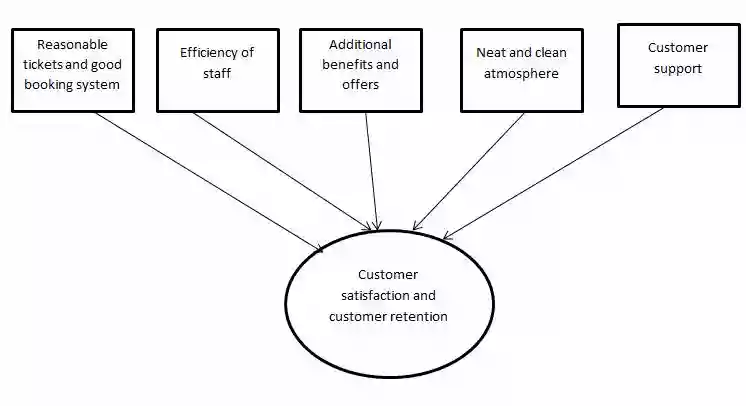
Kelley, L., Sheehan, K., and Jugenheimer, D.W., 2015. Advertising media planning: a brand management approach. Routledge.
Maehle, N. and Supphellen, M., 2015. Advertising strategies for brand image repair: The effectiveness of advertising alliances. Journal of Marketing Communications, 21(6), pp.450-462.
Morrison, C.P. and Fakih, W., 2017. Sign or Advertising Management Application for a Smart Phone. U.S. Patent Application 15/498,642.
Nolet, M., O'Kelley, C.B., Dilling, A.S. and Lu, F.B.H., AppNexus Inc, 2019. Advertising Platform Transaction Management. U.S. Patent Application 16/299,985.
Osotio, N.T., Sanchez, E.M.I., Sabel, D.C. and Nijhawan, S., Microsoft Corp, 2015. Intent and task driven advertising management in search. U.S. Patent Application 14/226,545.
Parviainen, P., Tihinen, M., Kääriäinen, J. and Teppola, S. (2017). Tackling the digitalization challenge: How to benefit from digitalization in practice. International journal of information systems and project management, 5(1), 63-77.
Patterson, T.F., Thompson III, G.R., Denning, D.W., Fishman, J.A., Hadley, S., Herbrecht, R., Kontoyiannis, D.P., Marr, K.A., Morrison, V.A., Nguyen, M.H. and Segal, B.H., 2016. Practice guidelines for the diagnosis and management of aspergillosis: 2016 update by the Infectious Diseases Society of America. Clinical Infectious Diseases, 63(4), pp.e1-e60.
Steelberg, R. and Steelberg, C., VERITONE, INC., 2016. System and method for creation and management of advertising inventory using metadata. U.S. Patent 9,294,727.
Taylor, S. J., Bogdan, R.and DeVault, M. (2015). Advertising management assignment. Introduction to qualitative research methods: A guidebook and resource. John Wiley & Sons.
Apendix Image 1: Advertisement management system
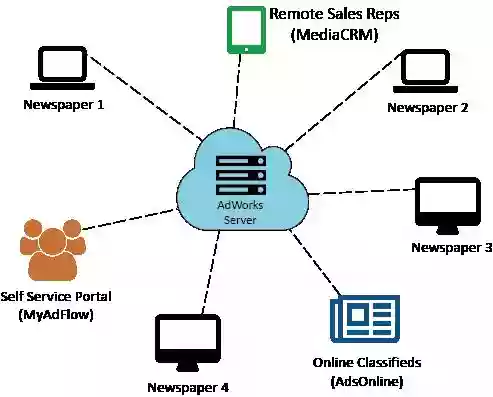
Image 2: Effective advertisement management system
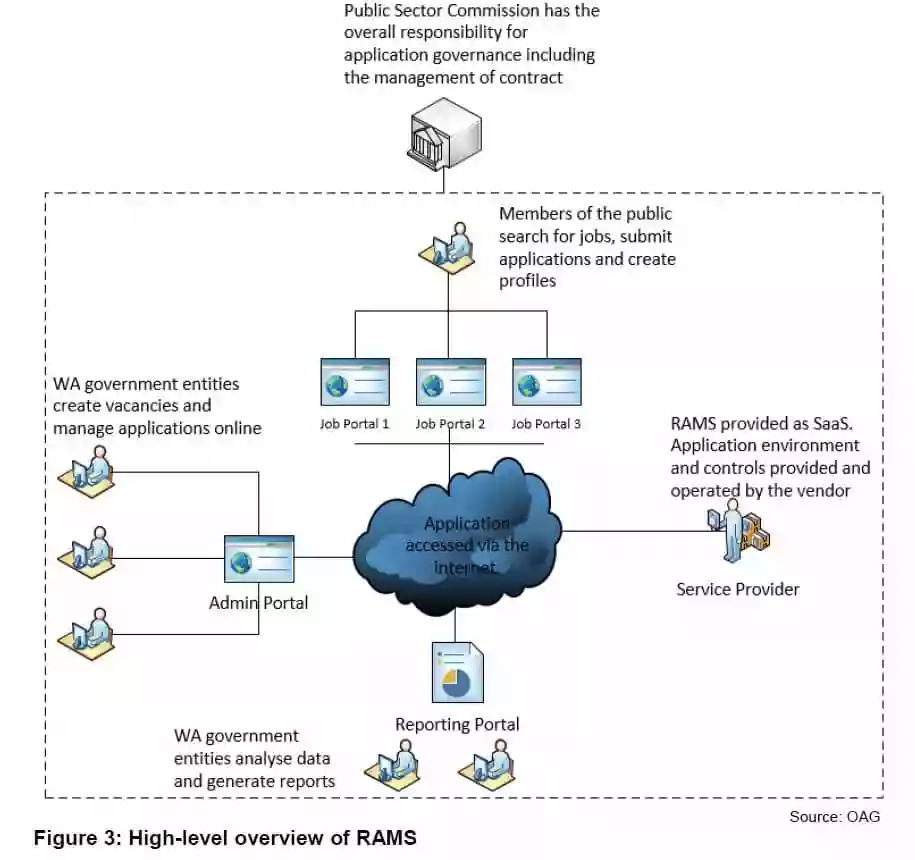
Get Top Quality Assignment Help and Score high grades. Download the Total Assignment help App from Google play store or Subscribe to totalassignmenthelp and receive the latest updates from the Academic fraternity in real time.
CHECK THE PRICE FOR YOUR PROJECT
Number of pages/words you require, choose your assignment deadline, related samples.
- Herbal Tea Enlightenment: A Comprehensive Digital Campaign Proposal for Twinnings Tea
- Navigating Professional Growth: A Reflection on Co-operative Education Experience at Post Haste
- Adapting Strategies: Navigating the Impact of Macro-Environment Factors on Kroger's Marketing Approach
- Harmony in the Park: A Sustainable Outdoor Music Event Marketing Plan
- Unveiling Marketing Strategies: A Personal Evaluation of Samsung S22 Purchase
- Journey through Entrepreneurial Leadership: A Reflection and Case Study Analysis
- Navigating Ethical Challenges: A Case Study on Wells Fargo's Sales Culture
- Unlocking the Power of Employee Motivation in Effective Management
- Impact of effective leadership strategies on the business performance of UK retail firms- A Case of Tesco
- Analysing the operational aspects for a new resort
- Analysing leadership approaches within a project environment
- Safeguarding Children's Welfare: Legal Protection Against Abuse
- Navigating Compassion and Law Enforcement: A Case Study Analysis
- Unveiling the Shadows: Understanding Drug Addiction in Australia
- Enhancing Patient Safety Through Medication Administration: A Case Study Analysis
- Climate Change's Impact on Corporate Social Responsibility: A Case Study of Viva Energies Australia
- Analyzing narrative techniques in a given reading
- Planning a web-based reporting system for Rimu Art
- The effects of technological implementations on sustainable development in the UK construction industry
- Child protection policy that has emphasis on an adoption approach versus child protection policy that has emphasis on use of intensive family support programs
- Reflective essay on understanding human development across the lifespan
- Evaluating different management support systems relating to information systems
- Evaluating gender discrimination in early childhood education in Australia
- Improving Early Education Standards for children and families
- Solution to economics questions based on international finance

Looking for Your Assignment?

FREE PARAPHRASING TOOL

FREE PLAGIARISM CHECKER

FREE ESSAY TYPER TOOL
Other assignment services.
- SCM Assignment Help
- HRM Assignment Help
- Dissertation Assignment Help
- Marketing Analysis Assignment Help
- Corporate Finance Assignment Help

FREE WORD COUNT AND PAGE CALCULATOR

QUESTION BANK
ESCALATION EMAIL
To get answer.
Please Fill the following Details
Thank you !
We have sent you an email with the required document.
What is a Advertising Manager?
Learn about the role of Advertising Manager, what they do on a daily basis, and what it's like to be one.
- What is a Advertising Manager
- How to Become
- Certifications
- Tools & Software
- LinkedIn Guide
- Interview Questions
- Work-Life Balance
- Professional Goals
- Resume Examples
- Cover Letter Examples
Start Your Advertising Manager Career with Teal
Definition of a Advertising Manager
What does a advertising manager do, key responsibilities of an advertising manager.
- Developing and implementing advertising strategies that align with the overall marketing goals of the company
- Leading and collaborating with creative teams to produce engaging and persuasive advertising content
- Conducting market research to identify target audiences and understand their behaviors and preferences
- Managing budgets and timelines for advertising campaigns to ensure cost-effectiveness and timely delivery
- Negotiating with media outlets, publishers, and vendors to secure optimal advertising spaces and rates
- Monitoring and analyzing the performance of advertising campaigns to measure effectiveness and ROI
- Adjusting advertising strategies based on analytics, market trends, and feedback to optimize results
- Collaborating with sales, marketing, and product development teams to ensure cohesive branding and messaging
- Staying abreast of industry developments, emerging media platforms, and advertising technologies
- Ensuring compliance with all relevant laws, regulations, and ethical standards in advertising practices
- Building and maintaining relationships with clients, stakeholders, and external agencies
- Providing leadership and direction to the advertising team, fostering a creative and productive environment
Day to Day Activities for Advertising Manager at Different Levels
Daily responsibilities for entry level advertising managers.
- Assisting with the development and execution of advertising campaigns
- Coordinating with creative teams, media planners, and buyers
- Monitoring campaign performance and compiling reports
- Participating in client meetings and briefings under supervision
- Managing campaign budgets and timelines for smaller projects
- Engaging in professional development opportunities to understand industry trends
Daily Responsibilities for Mid Level Advertising Managers
- Developing advertising strategies and plans for various clients
- Overseeing the creative and media buying processes
- Building and maintaining relationships with clients and media vendors
- Conducting market research and analyzing consumer data to inform strategies
- Managing budgets and negotiating contracts
- Presenting campaign ideas and results to stakeholders
Daily Responsibilities for Senior Advertising Managers
- Leading the development of comprehensive advertising strategies that align with business goals
- Managing and nurturing key client relationships and high-stakes accounts
- Directing the advertising team and overseeing all campaigns and projects
- Contributing insights and expertise to the company's long-term strategic planning
- Identifying new business opportunities and pioneering innovative advertising solutions
- Mentoring and developing talent within the advertising team
Types of Advertising Managers
Brand advertising manager, digital advertising manager, media planning and buying manager, creative advertising manager, account advertising manager, performance advertising manager, what's it like to be a advertising manager , advertising manager work environment, advertising manager working conditions, how hard is it to be an advertising manager, is an advertising manager a good career path, faqs about advertising managers, how do advertising managers collaborate with other teams within a company, what are some common challenges faced by advertising managers, what does the typical career progression look like for advertising managers.
How To Become a Advertising Manager in 2024

Related Career Paths
Shaping brand identity and driving market presence through strategic storytelling
Driving brand vision, orchestrating innovative strategies for market dominance
Driving online presence and engagement, leveraging digital channels for brand success
Navigating the media landscape to secure optimal ad placements for brand visibility
Driving brand visibility and growth through strategic paid media campaigns
Driving efficiency in marketing processes, optimizing strategies for business growth

- school Campus Bookshelves
- menu_book Bookshelves
- perm_media Learning Objects
- login Login
- how_to_reg Request Instructor Account
- hub Instructor Commons
- Download Page (PDF)
- Download Full Book (PDF)
- Periodic Table
- Physics Constants
- Scientific Calculator
- Reference & Cite
- Tools expand_more
- Readability
selected template will load here
This action is not available.

4.23: Assignment- Marketing Plan, Part I
- Last updated
- Save as PDF
- Page ID 47975
- Lumen Learning
Student Instructions: Complete the following information about the organization and products and/or services you will focus on as you develop a complete marketing plan throughout the course. You may need to do research to get answers to the questions below. Be sure the organization and offering you select will 1) remain interesting to you for the duration of the course, and 2) have sufficient information available for you to conduct research and make informed recommendations in your marketing plan.
Company Profile
- Company Name:
- Major products and/or services (names, types):
- Products and/or services your marketing plan will focus on:
- Target customers:
- Distribution channel(s):
- Headquarters (city, state, country):
- Year founded:
- Number of employees:
- Annual revenue (estimated)
- Key competitors:
- Link to Web site:
- Link to Yahoo! Finance information page (for public companies):
Market Segmentation and Targeting
- What problem does your product or service solve?
- Describe the total market for your solution: Who are potential customers?
- What are the key segments within this market?
- Identify and briefly describe 1–3 segments that this company serves.
- Which segment does this marketing plan focus on, and why? Why do you believe this segment will offer growth and profit opportunities?
Situation and Company Analysis
Economic environment.
Discuss factors that affect your consumers’ purchasing power and spending patterns. What is the economic environment that you are operating in? Is it a growth, recovery or recession? Will it be easy to find staff? What is the current interest rate i.e. is it increasing or decreasing? What is consumer confidence like?
Technical Environment
The technological environment changes rapidly. You need to make sure that you are aware of trends in your industry and other industries could affect your business. New technologies create new markets and can influence you consumers and competitors. Industry environment What are the trends in your industry? Are there new entrants in the market? Has a substitute product been introduced? Are there changes in industry practices or new benchmarks to use?
Competitive Environment
How many competitors do you have? Who are the key competitors? What are the key selling points or competitive advantages of each one. What is your advantage over competitors? Is the market large enough to support you and competitors?
Political Environment
Consider the political environment for the areas that your business will trade and operate in. Is there a stable political system? Are there any licenses and regulations that you should be aware of? Do you need to win support to be able to operate?
SWOT Analysis
Instruction: Complete the table below with descriptive responses and explanation as you answer the questions below.
- Does the organization have a strong brand presence?
- What resources are available for marketing activities?
- Does the the company have unique products or services that satisfy the needs of their target market?
- What makes the company’s products or services unique?
- What value is brought to customers?
- Does the organization have a weak brand presence?
- Are resources insufficient for marketing activities?
- Does the company lack distinctive products or services?
- Do current products or services fail to satisfy the needs of customers?
- Do current products or services fail to bring value to customers?
Opportunities
- What is the unique opportunity that the company is trying to take advantage of?
- Does the target market have any unfulfilled needs that the company can satisfy?
- Are there emerging target markets with needs that the company can satisfy?
- Are there ways the company and its competitors can benefit by working together?
- Are there opportunities for collaborating with customers to build brand presence?
- Describe and analyze if market demand is increasing?
- Are there changes in the government regulations that will affect the company?
- Describe any emerging global issues that will affect the company?
- What are the tactics that competitors use to pursue customers?
- What are the strengths of the company’s biggest and or emerging competitors?
- In what ways are the competitors’ products or services superior to the company’s offerings?
- How are competitors likely to respond to any changes in the way the company markets?
- Is the company behind in adopting new technologies for marketing?
- Describe any ways in which international competitors are taking away market share?
- What do customers dislike about the company?
- Describe and analyze if market demand is decreasing?
Mission, Objectives, and Goals
State the mission or business purpose: what the organization wants to achieve, in market-oriented terms. (Example: Disney’s mission could be, “We create happiness by providing the finest in entertainment for people of all ages.)
List 1–3 objectives that move the organization a step closer to achieving the mission. (Example: A Disney objective could be, “To be the most popular theme park for international visitors.”)
Convert objectives into specific marketing goals that are easy to measure and evaluate. (Example: Our goal is to increase market share of international theme park visitors by 10% in the next two years.”)
Sample Grading Rubric
Company profile grading rubric.
Total points possible for Company Profile Assignment: 10 pts.
Market Segmentation and Targeting Grading Rubric
Total points possible for Market Segmentation and Targeting Assignment: 10 pts.
Situation and Company Analysis Grading Rubric
Total points possible for Situation and Company Analysis Assignment: 50 pts.
Total points possible for Marketing Plan, Part 1 Assignment (Consists of Company Profile Assignment, Market Segmentation and Targeting Assignment, and Situation and Company Analysis Assignment combined): 100 pts.
Contributors and Attributions
- Assignment: Marketing Plan, Part I . Provided by : Lumen Learning. License : CC BY: Attribution
- SWOT and Integrated Marketing Communications Templates. Authored by : Melissa Barker. License : CC BY: Attribution
Persuasive Techniques in Advertising

- Resources & Preparation
- Instructional Plan
- Related Resources
Students will learn persuasive techniques used in advertising, specifically, pathos or emotion, logos or logic, and ethos or credibility/character. They will use this knowledge to analyze advertising in a variety of sources: print, television, and Web-based advertising. Students will also explore the concepts of demographics and marketing for a specific audience. The lesson will culminate in the production of an advertisement in one of several various forms of media, intended for a specific demographic.
Featured Resources
The Art of Rhetoric: Persuasive Techniques in Advertising : This online video describes how advertisers use pathos or emotion, logos or logic, and ethos or credibility/character in order to persuade consumers.
Persuasive Techniques in Advertising Video Transcription : A transcript of the video provided by Chelsea Majors
From Theory to Practice
Students encounter advertising at every turn of their lives: on public billboards, during nearly every television show, on the Internet, on their cell phones, and even in schools. They are undoubtedly aware that these ads have a specific purpose: to sell something to them. Rarely, however, do teenagers think precisely about how the text, sounds, and images in these advertisements have been carefully crafted to persuade them to purchase a product or service-and that these techniques are not far from those they have already used in their own persuasive writing. We emphasize the need to make our students more literate, and this lesson aims to improve their critical media literacy. By reducing advertising to its basic rhetorical components, students "can begin to understand how to construct their own messages to convey the meanings they intend and to evoke the responses they desire" (173). Becoming more media literate allows our youth to "create messages of their own so that they can communicate clearly, effectively, and purposefully" (176). Further Reading
Common Core Standards
This resource has been aligned to the Common Core State Standards for states in which they have been adopted. If a state does not appear in the drop-down, CCSS alignments are forthcoming.
State Standards
This lesson has been aligned to standards in the following states. If a state does not appear in the drop-down, standard alignments are not currently available for that state.
NCTE/IRA National Standards for the English Language Arts
- 1. Students read a wide range of print and nonprint texts to build an understanding of texts, of themselves, and of the cultures of the United States and the world; to acquire new information; to respond to the needs and demands of society and the workplace; and for personal fulfillment. Among these texts are fiction and nonfiction, classic and contemporary works.
- 3. Students apply a wide range of strategies to comprehend, interpret, evaluate, and appreciate texts. They draw on their prior experience, their interactions with other readers and writers, their knowledge of word meaning and of other texts, their word identification strategies, and their understanding of textual features (e.g., sound-letter correspondence, sentence structure, context, graphics).
- 4. Students adjust their use of spoken, written, and visual language (e.g., conventions, style, vocabulary) to communicate effectively with a variety of audiences and for different purposes.
- 6. Students apply knowledge of language structure, language conventions (e.g., spelling and punctuation), media techniques, figurative language, and genre to create, critique, and discuss print and nonprint texts.
- 8. Students use a variety of technological and information resources (e.g., libraries, databases, computer networks, video) to gather and synthesize information and to create and communicate knowledge.
- 12. Students use spoken, written, and visual language to accomplish their own purposes (e.g., for learning, enjoyment, persuasion, and the exchange of information).
Materials and Technology
- Video of television program, including commercials
- TV with VCR/DVD player
- Advertisements from magazines
- Persuasive Techniques in Advertising online video
- Persuasive Techniques in Advertising Video Transcription
- Internet-connected computer with speakers and projector
- Web Resources for Finding Example Advertisements
- Demographics: Who Are You?
- Advertising Advantages: Television vs. Print vs. Online
- Targeted Commercials
- Commercial Dig
- Commercial Dig Reflection Questions
- Analyzing Ads
- Planning Your Advertisement
- Commercial Assessment
- Persuasive Techniques in Advertising Reflection Questions
Preparation
- Make copies of the necessary handouts.
- Gather advertisements from magazines-ideally, two per student. Look for ads that lend themselves well to the assignment, with a balance of text and images and with fairly discernable examples of pathos, logos, and ethos. Consider asking your school library media specialist for issues of magazines he or she plans to discard.
- Record at least part of a television program, including the entirety of one commercial break, for showing in class.
- If students will be using the Venn Diagram , Comic Creator , or Printing Press , arrange for them to have access during the appropriate sessions.
- Preview the Persuasive Techniques in Advertising online video and obtain proper technology for projecting it in the classroom or computer lab. Also check out the Persuasive Techniques in Advertising Video Transcription .
- Arrange for students to have access to computers for Sessions Three and Four.
- Bookmark the Web Resources for Finding Example Advertisements and preview the sites before recommending which ones students visit for example advertisements.
- Familiarize yourself with the technologies discussed in the final session, deciding which you are prepared to ask or require students to use in the production of their own ads. Contact your school library media specialist or technology specialist for assistance.
Student Objectives
Students will
- demonstrate an understanding of three persuasive techniques (pathos, logos, and ethos) and other advertising strategies.
- analyze advertisements according to their employment of these techniques.
- demonstrate an understanding of the concept of demographics and specific audience.
- synthesize this knowledge into advertisements of their own creation.
Session One
- Where do you encounter advertising? (They will likely mention television, billboards, radio, Websites, school hallways, and so on.)
- Which specific advertisements "stick in your head?"
- What makes these advertisements memorable? (They might mention music, catchy slogans, celebrity appearance, the appeal of the product itself, and so forth.)
- Do you think advertisements have an effect on your personal interests?
- Explain to students that advertisers very carefully construct their ads to make them memorable and appealing to consumers, and that the ways in which they try to convince them to buy products are similar to the ways they have been taught to write persuasively, using certain techniques and aiming toward a particular audience.
- Distribute the Persuasive Techniques in Advertising handout and introduce the concepts of pathos, logos, and ethos, defined at the top of the handout. Students should understand that these rhetorical strategies are similar to those used in a persuasive writing assignment, and that they will use these strategies when creating their own commercial by the end of this unit. Encourage students to make connections to examples of each of the terms they have used in persuasive writing of their own. Note: This is an appropriate time to clarify that the word logos in this context should not be confused with a brand-specific image or insignia referred to as a logo.
- After explaining the concepts of pathos, logos, and ethos, have students practice identifying the three techniques by placing a P , L , or E in the blank next to the examples at the bottom of this handout. Have students share their responses with a partner and check for understanding by conducting a brief discussion of the examples.
- Although most of these examples were designed to have one clear answer, be sure to emphasize to the students that pathos, logos, and ethos are not always separate entities and may often overlap with one another. For example, "Nine out of ten dentists choose Crest," suggests that the dentists are credible experts (ethos), and also includes a statistic (logos).
- Deepen students' understanding of the concepts of pathos, logos, and ethos with visual examples by sharing with them the Persuasive Techniques in Advertising online video . You may want to pause and have students explain how the television, print, and online advertisements utilize the three rhetorical strategies. The narration in the commercial further explains their use in each advertisement. There is also the Persuasive Techniques in Advertising Video Transcription .
- Briefly discuss the "Other Advertising Strategies" section of Persuasive Techniques in Advertising handout. Explain that these are more specific types of strategies that advertisers use and that many overlap with pathos, logos, and ethos. For example, you may mention that patriotism is a strategy meant to evoke certain emotions, and would therefore constitute a use of pathos.
- Close the session by explaining to students that in future sessions, they will be examining existing advertisements with their new analytical skill and applying it to creating ads of their own.
- Encourage students to begin looking at advertisements they encounter in terms of these three techniques.
Session Two
- Begin with a brief review of the concepts of pathos, logos, and ethos from the previous session. Ask students to demonstrate their growing understanding by providing examples of each of the techniques from advertisements they have recently seen.
- Now introduce the term demographics to students: the characteristics that make up a human population such as gender, age, and race. Have students discover which demographic group(s) they fit into by completing the Demographics: Who are you? handout. When creating their group commercials in a later session, students will need to consider the demographics for their product. Explain to students that this is how advertisers think of consumers: not as individuals, but as members of groups that tend to believe, behave, or purchase in certain patterns. Even when an advertisement is appealing to the idea of individuality (such as Burger King's "Have It Your Way" promotion), advertisers are appealing to the demographic group of "people who like to be thought of as individuals," not to any single consumer.
- Continue the discussion of demographics by distributing the Targeted Commercials handout, which will further explore the concept of demographics. Ask students to begin applying their understanding of demographics and targeted advertising by showing the first part of a television program of your choice. Since the purpose of this activity is to show how advertisers cater to a show's intended audience, you may want to make sure you are presenting a show with commercials that very obviously target a specific demographic.
- Before watching, share with students a brief description of the show they are about to see, including race/gender/class of the main characters, genre of the program, and the time/date/channel on which the program aired. Have students use these factors (and any other prior knowledge they may have of the show) to determine the probable demographics. Students should indicate their choices on the handout .
- While students watch the commercial break(s), have them take brief notes to remind them of the products being advertised.
- Have students complete the "After the program" response question at the bottom of the Targeted Commercials handout. Then discuss the degrees to which the advertisements match the demographics of the likely intended audience of the television program.
- This would be an appropriate time to talk about clear evidence that programming and advertising are marketed to specific groups. Lifetime: Television for Women, Spike! TV, Logo, and Black Entertainment Television all exist not only to give viewers programming they might like, but also to allow advertisers to target their audiences more specifically.
- Distribute the Commercial Dig activity, explaining to students that this is a long-term assignment that requires them to keep track of eight commercials viewed during one television program and to explain briefly the purpose of each advertised product. Remind students that the commercials they record on this chart should all come from the same show, as the completed chart will be used to re-emphasize the concepts of demographics and targeted advertising. Inform them that this assignment should be completed by Session Four and ask if there are questions before closing the session.
Session Three
- Remind students what they have learned so far in this lesson: techniques advertisers use to persuade consumers to buy their products and the concept of "targeting" certain audience demographics to make the process of persuasion more efficient and focused.
- Explain to students that they will have the opportunity to apply this knowledge by looking at some real ads for real products. Share that the goal of this activity will be to examine how advertisers skillfully use multiple strategies to persuade their audiences.
- Distribute the Analyzing Ads handout and discuss the expectations and format for response. Students will analyze six advertisements: two print ads, two television commercials, and two Internet advertisements. The Internet advertisements should take the form of marketing Websites featuring a particular product, or pop-ups/embedded ads in Websites unrelated to the product.
- This activity will allow students to practice their recognition of pathos, logos, and ethos in three different modes of advertising, preparing them for the creation of their own commercials. Students should also record any of the "other strategies" explained on Persuasive Techniques in Advertising handout, also required as part of the final project.
- Share with students the print ads you already collected as well as the Web Resources for Finding Example Advertisements and have them look for ads. Point out to students that they may wish to access television ads on their own time, including during their work on the Commercial Dig activity. Depending on how efficiently students work through this activity, this part of the lesson will likely extend into the next session.
Session Four
- At an appropriate time in student engagement in the continuation of the analysis activity from the previous session, distribute the Commercial Assessment rubric and explain that you will use it to evaluate the commercials they will produce in an upcoming session. Ask students, in small groups, to review one of the teacher- or student-selected commercials and apply the rubric to the commercial. Students should determine whether the commercial effectively utilizes pathos, logos, and/or ethos, and note their score on the rubric . Students should also indicate the effectiveness of any of the "other strategies" on the second page of the rubric .
- When students are ready, check for understanding by several volunteers present one of the advertisements they analyzed, briefly discussing the effective use of persuasive techniques.
- Wrap up this section of the lesson by using the Advertising Advantages: Television vs. Print vs. Online to engage students in a discussion of the advantages of each mode of advertising, using the examples on the handout as a guide. This discussion will help students decide which modes of advertising they might use when creating their commercials in the next session. You may wish to use the Venn Diagram to facilitate this discussion.
- Remind students that they will need to have their completed Commercial Dig activity ready for discussion in the next session.
Session Five
- Ask students to get out their completed Commercial Dig activity sheets. Give students the opportunity to solidify their understanding of the concept of demographics by working through the analysis tasks in the Commercial Dig Reflection Questions . Have students use their completed charts to answer the reflection questions . Students should talk through their responses with a partner before producing a written response.
- Which advertisements could be viewed as harmful or unfair to a group of people?
- Can targeting a specific demographic sometimes encourage stereotyping?
- When do you see stereotyping used in advertisements?
- You may wish to give students access to the online articles Target me with your ads, please and Mixed Messages , which discuss how Websites use technology to target consumers and the use of billboards in impoverished and minority neighborhoods, respectively, as part of this discussion.
Session Six
- Students will use this session to begin to synthesize all they have learned about advertising and begin creating a commercial for a fictional product. First ask students to form small groups and decide on a product to advertise.
- Next, students should determine the target audience for their product, remembering previous lessons on demographics.
- Depending on available time and resources, ask students to create a print, filmed, live, and/or Internet advertisement for their product. They should take into account their observations from the Advertising Advantages: Television vs. Print vs. Online .
- Have students use the Planning Your Advertisement sheet to plan for an advertisement that will target the previously determined demographic, and demonstrate pathos, logos, ethos, and three of the "other strategies." This may also be an appropriate time to review the expectations set forth in the Commercial Assessment rubric.
- Give students access to the Comic Creator and/or the Printing Press to create the print advertisement. Free software such as iMovie and Windows Movie Maker may be used to edit any filmed commercials. Web creation sites such as PBWorks and Google Sites may be used to create Internet-based advertisements.
Session Seven (after students have had time to prepare their advertisements)
- Give students time to meet in their groups and plan the presentation of their ads.
- Have each group present, allowing time for discussion with the class about the effective use of persuasive techniques in each advertisement.
- After the presentations and discussion are complete, distribute the Persuasive Techniques in Advertising Reflection Questions and give students time to solidify their learning by responding to the four questions.
Student Assessment / Reflections
- Use the lesson reflection questions to allow students to think about what they have learned about advertising and persuasion.
- Use the Commercial Assessment rubric to assess student work on their advertisements.
- Professional Library
- Student Interactives
- Lesson Plans
- Strategy Guides
- Calendar Activities
The Comic Creator invites students to compose their own comic strips for a variety of contexts (prewriting, pre- and postreading activities, response to literature, and so on).
The interactive Printing Press is designed to assist students in creating newspapers, brochures, and flyers.
This interactive tool allows students to create Venn diagrams that contain two or three overlapping circles, enabling them to organize their information logically.
Students analyze rhetorical strategies in online editorials, building knowledge of strategies and awareness of local and national issues. This lesson teaches students connections between subject, writer, and audience and how rhetorical strategies are used in everyday writing.
Add new comment
- Print this resource
Explore Resources by Grade
- Kindergarten K

Advertising Management
The Advertising Management though is a complex process of employing various media to sell a product or service. This process begins quite early from the marketing research and encompasses the media campaigns that help sell the product. Without an effective advertising management process in place, the media campaigns are not that fruitful and the whole marketing process goes for a toss.
The advertising management focuses on creating the specifics for the overall advertising campaign. If it is a radio campaign, which type of ads would be used, if it is a print campaign, what write ups and ads will be used, and if it is a television campaign, what type of commercials will be used. There might also be a mix and match advertising in which radio might supplement television advertising and so on. It is important that through advertising management the image is conveyed that all the strategies complement each other. It should not look to public that the radio advertising is focusing on something else while television on something else.
The role of people designing the advertising campaign is crucial to its success. They have been trained by seasoned professionals who provide the training in the specific field. Designing an advertising campaign is no small a task and to understand the consumer behavior from the data collected from market research is a very important aspect of the campaign. A whole lot of creativity and inspiration is required to launch an adequate advertising campaign.
Describe Restaurant Business Marketing
Guidelines for assembly product positioning, postal packaging supplies, define and discuss on marketing communications, post evaluation of five major capital expenditures at ubl, local multiplier effect, nash equilibrium overview, smartphone app can lead to change your personality within three months, disruptive innovation, discuss on midoceanic ridges, latest post, mid-ocean ridge (mor), harnessing hydrogen at the genesis of life, ngc 5728’s faint characteristics are exposed, astronomers discover the oldest black hole ever observed, atomic hydrogen welding, variable-frequency transformer (vft).
Browse Course Material
Course info.
- Prof. John Hauser
Departments
- Sloan School of Management
As Taught In
Learning resource types, marketing management: analytics, frameworks, and applications, action learning assignment, action learning: exercise on the practice of marketing.
Throughout the semester we use the 4 P’s and 5 C’s of marketing to focus on delivering benefits profitably to our customers. We explore how product design is based on customer needs, how advertising communicates those needs in a manner consistent with the customers’ search process, and how the channel of distribution is both a means to satisfy the end customer and is a customer itself. We also explore many methods to gather customer information including focus groups, one-on-one interviews, and conjoint analysis. This exercise asks you to synthesize many of those ideas.
Step 1. Select a firm whose marketing strategy and tactics you will study. This can be the firm for which a member in your group has worked, a competitor, or just a firm (or a division of that firm) that you find interesting. This firm can either manufacture products, deliver services, or both. It can be B2C or B2B. You are welcome to select either the MIT Undergraduate Program, the MIT Sloan MBA program, the MIT Sloan Fellows Program in Innovation and Global Leadership, or another MIT program as the topic of this exercise.
Step 2. Identify the firm’s customers. If the firm is large, narrow the focus to something feasible. For example, if you choose the MIT Sloan MBA program, the customers include the current students (you), alumni of the program, recruiting firms for students, the rest of MIT, and the general public. Customers also include potential students, your former and future supervisors, the faculty, and the Sloan school. If you choose a manufacturing firm, do not forget the channel.
Step 3. Talk to these customers. Pick a few representative customers from two or more categories (for example, end user and channel). If each of you talks to two customers that is enough for the purposes of the course—naturally more interviews would be necessary for a real business decision. You should talk about customer needs, what the firm does well and poorly relative to competition, how the customers gather information, acquire the product or service, etc.
Step 4. Answer the following questions based on the information in Step 3. The questions you emphasize will depend, in part, on what you learn in Step 3. You are encouraged to quote from the customer interviews.
- Product. How are the firm’s products or services perceived? What are their strengths and weaknesses relative to competition from the customers’ viewpoint? Are there unmet needs? Are there any opportunities for improvement? Etc.
- Promotion. How do the customers learn about the firm’s products or services? About competitors? What do they think of the firm’s communication materials? How would you improve the firm’s communication activities?
- Place. What needs do the channels for this product fulfill? Needs of the customer? Needs of the firm? Is there any conflict in the channel? How would you improve the firm’s channel activities?
- Price. How do the customers (channel) react to the firms’ prices? Are there any actions the firm to set its prices consistently with its strategy? Is the firm using any marketing cues or marketing theory to affect customer perceptions of its prices?
- General Marketing Strategy. What else did you learn from these discussions with customers that can improve the firm’s marketing strategy?
You are should submit a report that is approximately five pages long. Your report may be in bullet point form. You may include additional exhibits to substantiate your recommendations. Many students choose to summarize the voice-of-the-customer interviews in an exhibit.
The first page should be a summary of your recommendations and indicate which of the 4 P’s (and 5 C’s) need to be addressed to improve the firm’s marketing strategy. This page should include at least one recommended action in addition to the careful diagnosis of the firms’ marketing strategy and tactics.
The addition pages should address each of the 4 P’s, any of the 5 C’s that you feel are relevant , and the general marketing strategy of the firm. Your emphasis on the 4 P’s (and 5 C’s) can vary from a sentence or two to a page, depending upon which aspect you feel is key to your recommendations. If a P or C is not relevant, make sure you indicate that it is not relevant and why. If the firm is doing just fine with respect to any of the P’s and C’s, so indicate. Use headings to highlight the issues you are answering.
Your format should start with the most obvious points and then work from there. Make sure that you give both the pros and the cons of each recommendation. (After all, if the firm is not already implementing your recommendation, it might have a very good reason for not doing so.) You should structure your answers using sub-headings, if necessary, to make it clear that you have used an analytical approach to reach you answers.
It is critical that you tie your answers to the information that you gathered in Step 3 . The use of example quotes is often the best way to do this. Good luck.
Example Projects from Previous Years
In the past students have asked for examples of “A” projects from previous years. I have posted example projects (with your classmates permission).
All are excellent examples, but there are many ways to complete an action-learning project successfully. We wish to encourage deep analysis and creativity. Go in the directions that you feel best fulfill the assignment.
Perhaps your project will make the list for Fall 2016.

You are leaving MIT OpenCourseWare
Academia.edu no longer supports Internet Explorer.
To browse Academia.edu and the wider internet faster and more securely, please take a few seconds to upgrade your browser .
Enter the email address you signed up with and we'll email you a reset link.
- We're Hiring!
- Help Center

Marketing Management Assignment

Related Papers
Giovanni Morra
University of Roehampton submitted paper
Tapas Chakraborty
SKIREC Publication- UGC Approved Journals
The purpose of this research is to examine the effects of external environment pertaining to the marketing strategy of Starbucks, a coffee chain in Malaysia. An external environmental analysis has been conducted to examine the environment in which the company operates. These paper overviews several theoretical approaches to explore the strategic marketing planning process of the Starbucks Malaysia.
Douglas Holt
Branding has become one of the most important aspects of business strategy. Yet it is also one of the most misunderstood. Branding is sometimes considered to be merely an advertising function. And many managers and business writers hold the view that branding is about the management of product image, a supplementary task that can be isolated from the main business of product management. This note provides an alternative perspective, arguing that: • Branding is a strategic point of view, not a select set of activities. • Branding is central to creating customer value, not just images. • Branding is a key tool for creating and maintaining competitive advantage. • Brands are cultures that circulate in society as conventional stories. • Effective brand strategies must address the four distinct components of brand value. • Brand strategies must be " engineered " into the marketing mix. This note develops a set of concepts and frameworks to guide the design of brand strategies. From Value Proposition to the Brand Marketing strategies begin with the value proposition: the various types and amounts of value that the firm wants customers to receive from the market offering. The value proposition is value as perceived by the firm, value that the firm seeks to " build " into the product. 1 In marketing, the value proposition is sometimes referred to as the positioning statement. 2 Common wisdom in business often assumes that product value as measured by the firm and product value as experienced by the customer are identical. If the firm builds a better product, customers will experience it as such. Marketing makes a crucial break with this assumption. Marketing emphasizes that customer value is perceptual, never objective fact. Value is shaped by the subjective understandings of customers, which often have little to do with what the firm considers to be the " objective " qualities of the product. The brand is the product as it is experienced and valued in everyday social life. The verb " to brand " refers to all of the activities that shape customer perceptions, particularly the firm's activities. Branding, then, is a management perspective that focuses on shaping the perceived value of the product as found in society. 1 To simplify the exposition, I use the term " product " generically to refer to all types of market offerings—products, services, events, knowledge, etc.—and to include augmented aspects of the product (such as the service outputs delivered by the marketing channel). 2 The traditional positioning statement has three important weaknesses that this note seeks to correct. First, positioning statements are devoid of strategic focus. Second, positioning statements fail to recognize that the brand has a history, a brand culture, as developed below. The branding goal for an existing brand must be to move the brand from Point A to Point B. The strategy should recognize this. Finally, positioning statements do not isolate the four distinct components of brand value (below) and the relationships between these components. As a result, positioning statements can lead to vague brand strategies that fail to direct marketing actions.
Hebert Lobo
International Journal of Research in Undergraduate Mathematics Education
Benjamin Rott
Digital transformation has made possible the implementation of environments in which mathematics can be experienced in interplay with the computer. Examples are dynamic geometry environments or interactive computational environments, for example GeoGebra or Jupyter Notebook, respectively. We argue that a new possibility to construct and experience proofs arises alongside this development, as it enables the construction of environments capable of not only showing predefined animations, but actually allowing user interaction with mathematical objects and in this way supporting the construction of proofs. We precisely define such environments and call them “mathematical simulations.” Following a theoretical dissection of possible user interaction with these mathematical simulations, we categorize them in relation to other environments supporting the construction of mathematical proofs along the dimensions of “interactivity” and “formality.” Furthermore, we give an analysis of the funct...
LWT - Food Science and Technology
Gun Wirtanen
Structural Health Monitoring 2015
Peter Runcie
O rural em regiões metropolitanas: a Fazenda Engenho Novo, São Gonçalo
RELATED PAPERS
Brain and Spine
S. Ghanaati
Lusi Karohmah
Carlos manuel Carata soto
Pradnya Paramytha
Azzam Sleit
Journal of endodontics
Konstantinos Tosios
Denis Pouchain
rajesh waghmare
Jurnal Kesehatan Holistic
Tri Setyaningsih
DIPONEGORO MEDICAL JOURNAL (JURNAL KEDOKTERAN DIPONEGORO)
Ayu Prabandani
Journal of Food Measurement and Characterization
Aditi Agarwal , Komal Chauhan
Frontiers in Psychiatry
Steve Matthews
Vincent Hervet
Value in Health
Lara Wolfson
Cadernos PROLAM/USP
Gia Huy 24-Trần
Journal of Pineal Research
Francisco Javier Valenzuela Melgarejo
Experiments in Fluids
Jerry Westerweel
Geologie En Mijnbouw
Joost M.E. Pennings
Journal of Engineering and Information Technology for Community Service
Arie Qurania
See More Documents Like This
RELATED TOPICS
- We're Hiring!
- Help Center
- Find new research papers in:
- Health Sciences
- Earth Sciences
- Cognitive Science
- Mathematics
- Computer Science
- Academia ©2024
- Degree Completion Plans
- Course Guides
- Supplemental Instruction
- IT Helpdesk
- Academic Departments
- Doctoral Degrees
- Communications
- Criminal Justice
- Public Policy
- Strategic Leadership
- Worship Studies
- More Programs >
- Masters Degrees
- Applied Psychology
- Business Administration
- Clinical Mental Health Counseling
- Executive Leadership
- Healthcare Administration
- Political Science
- Public Administration
- Social Work
- Bachelor's Degrees
- Graphic Design
- Information Technology
- Paralegal Studies
- Sports Management
- Associate Degrees
- Christian Counseling
- Creative Writing
- Early Childhood Education
- Information Systems
- Interdisciplinary Studies
- Medical Office Assistant
- STEM Mathematics
- Undergraduate
- Christian Ministry
- Data Networking
- Project Management
- Biblical Studies
- Educational Tech. & Online Instruction
- General Business
- Health Promotion
- Theological Studies
- Curriculum and Instruction
- Instructional Design
- Higher Ed. Administration
- Special Education
- New Programs
- Biblical Counseling (BS)
- Chaplaincy (MA)
- Christian Leadership – Faith-Based Consulting (PhD)
- Educational Research (PhD)
- Fire Administration – Emergency Medical Services (BS)
- Geographic Information Systems – Commercial Logistics (MS)
- Healthcare Law and Compliance (MBA)
- Instructional Design and Technology (EdS)
- Interdisciplinary Research (MA)
- International Relations – Human Rights (MS)
- Philosophy, Politics, and Economics (BS)
- Special Education (EdD)
- Who Are We?
- Our Three A's
- Virtual Tour of Liberty's Campus
- What is a Nonprofit University?
- Why Choose Liberty?
- Accreditation
- Top 10 Reasons to Choose Liberty University
- Video Testimonials
- Annual Security Report
- Annual Security Report 2023
- Admission Information
- Getting Started With Liberty
- Admission Process
- Admission FAQs
- Academic Calendar
- Admission Resources
- Common Forms and Documents
- Technical Requirements
- Official Transcript Request Form
- Textbooks and Software
- Transferring to Liberty
- Transfer Students
- Experience Plus – Credit for Life Experience
- Transfer FAQs
- University Transcript Request Links
- Tuition Assistance
- First Responder Discount
- Military Tuition Discount
- Small Business Discount
- Corporate Tuition Assistance
- Corporate Tuition Affiliates
- Financial Basics
- Tuition & Fees
- Payment Plans
- Military Benefits
- Financial Check-In
- Financial Aid
- Financial Aid Process
- Financial Aid FAQs
- Grants & Loans
- Scholarship Opportunities
- Military Homepage
- Military Benefits Guide
- Discount on Tuition
- Doctoral Military Rate
- Veterans Benefits
- Academics and Programs
- Military Programs and Partnerships
- Military Benefits and Scholarships
- Community and Resources
- Top Used Links
- Upcoming Events
- Academic Advising
- Jerry Falwell Library
- Policies and Deadlines
- Liberty University Academic Calendar Online
- Academic Policies
- Information Technology (IT)
- Online Writing Center
- Honor Societies
- Student Advocate Office
- Flames Pass (Student ID)
- Online Student Life
- Office of Disability Accommodation Support
- Commonly Used Forms
- learn.liberty.edu
Strategic Marketing Management – BUSI 520
CG • Section 8WK • 11/08/2019 to 04/16/2020 • Modified 02/01/2024
Request Info
Course Description
For information regarding prerequisites for this course, please refer to the Academic Course Catalog .
In order to market successfully and efficiently, a marketer must thoroughly understand and properly apply the principles of managing a marketing strategy. Developing a strategic marketing plan is a multifaceted task that requires research, analysis, and decision making. This course provides the student with knowledge and practice related to crafting a viable marketing plan.
Course Assignment
Textbook readings and lecture presentations
After reading the Course Syllabus and Student Expectations , the student will complete the related checklist found in the Course Overview.
Discussions (2)
Discussions are collaborative learning experiences. Therefore, the student will create a thread in response to 1 of the available topics. The thread must be at least 600 words, reference at least 2 scholarly or practitioner sources in addition to the course textbook in current APA format, and demonstrate course-related knowledge. In addition to the thread, the student will reply to at least 2 other classmates’ threads. Each reply must be least 250 words and reference at least 1 scholarly or practitioner source in addition to the course textbook in current APA format.
Marketing Management Individual Project (MMIP) Assignments (6)
Discover Marketing Management Assignment
Each student must provide a description of the product/service and a brief history of the firm that produces the product/service. Assignments must include a title page that has the name of the project topic and the specific questions being addressed from the prompt, be at least 600 words (12-point Times New Roman font, double spaced), and include a separate references page. The same project topic must be used in all installments. This will be reviewed for plagiarism by Turnitin.
Use Information to Drive Marketing Decisions Assignment
Each student must analyze the consumer market and market segments for its product/service. Assignments must include a title page that has the name of the project topic and the specific questions being addressed from the prompt, be at least 600 words (12-point Times New Roman font, double spaced), and include a separate references page. The same project topic must be used in all installments. This will be reviewed for plagiarism by Turnitin.
Develop Value Offering Product Experience Assignment
Each student must describe the positioning, competition, and branding for the product/service. Assignments must include a title page that has the name of the project topic and the specific questions being addressed from the prompt, be at least 600 words (12-point Times New Roman font, double spaced), and include a separate references page. The same project topic must be used in all installments. This will be reviewed for plagiarism by Turnitin.
Price and Deliver Value Offering Assignment
Each student must describe the support services, pricing, and distribution of the product/service. Assignments must include a title page that has the name of the project topic and the specific questions being addressed from the prompt, be at least 600 words (12-point Times New Roman font, double spaced), and include a separate references page. The same project topic must be used in all installments. This will be reviewed for plagiarism by Turnitin.
Communicate the Value Offering Assignment
Each student must analyze the promotions and socially responsible marketing associated with the product/service. Assignments must include a title page that has the name of the project topic and the specific questions being addressed from the prompt, be at least 600 words (12-point Times New Roman font, double spaced), and include a separate references page. The same project topic must be used in all installments. This will be reviewed for plagiarism by Turnitin.
Recommendations Assignment
Each student will submit a 600-word recommendations document based on information gathered over the course of the session while completing the project installments. A minimum of five strategic and five operational recommendations must be offered. The student will add scriptural integration throughout the recommendations, quoting relevant scripture verses as appropriate. There must be a minimum of 10 relevant scriptural quotes found throughout the recommendations document, with their relevance to the recommendations explained. This must include a title page, a brief introduction delineating the recommendations, and a separate section (with heading) for each recommendation. At least 5 scholarly or practitioner sources (in addition to the Bible) must be used. The 600-word requirement does not include the title page, scriptural quotes, or references. The same project topic must be used in all installments. This will be reviewed for plagiarism by Turnitin.
Integration of Faith and Learning Assignments (2)
The student will complete 2 Integration of Faith and Learning (IFL) essays that are at least 500 words each, use 2 scholarly or practitioner sources, are in current APA format, and are submitted as Microsoft Word documents. The student will contemplate the assigned Scripture verse and relate it to marketing management. This will be reviewed for plagiarism by Turnitin.
Almost there! How may we contact you?
Our Admissions team is ready to answer any additional questions you may have.
By submitting contact information through this form, I agree that Liberty University and its affiliates may call and/or text me about its offerings by any phone number I have provided and may provide in the future, including any wireless number, using automated technology.
Message and data rates may apply. For additional information, text HELP to 49595 or 49596. You may opt-out at any time by sending STOP to 49595 or 49596. Visit for Terms & Conditions and Privacy Policy.
- Get My Results
Discover what Liberty can do for you!
Get your personalized guide on how to start with liberty..
In 60 seconds or less!
Become a Champion for Christ
Estimate your Cost
Cost Per Credit Hour Per Semester for 7 to 15 Credits* Per Semester for 9 to 15 Credits* i Visit the Tuition and Financing page for more information.
Additional program fees may apply. See program page for details.
Disclaimer: This calculator is a tool that provides a rough estimate of the total cost of tuition, and should not be relied upon to determine overall costs, as pricing may vary by program and tuition/fees are subject to change. Estimates are not final or binding, and do not include potential financial aid eligibility.
Your Cost Estimate:
View All Tuition & Fees Go Back
For eligibility requirements for military discounts at the doctoral level, please review the online benefits page .
Request Information
Learn More About Liberty University Online
You will be automatically taken to the application once you submit your request for information
Message and data rates may apply. For additional information, text HELP to 49595 or 49596. You may opt-out at any time by sending STOP to 49595 or 49596. Visit for Terms & Conditions and Privacy Policy .
You have to have a lot of self-motivation and self-discipline when you are going to school online, but the amazing thing is at Liberty you do not need to do it by yourself. You really do have resources like someone who is going to school on campus.
– Janae Fleming ’15, B.S. in Education
- Study Guides
- Homework Questions
Assignment 2 - FAN Zhanhao

DESIGN & REKLAMA 20 th Exhibition of Advertising Industry APRIL 15-18, 2014, Moscow, CHA
Sep 23, 2014
120 likes | 297 Views
DESIGN & REKLAMA 20 th Exhibition of Advertising Industry APRIL 15-18, 2014, Moscow, CHA. DESIGN & REKLAMA, the largest exhibition of the advertising industry, will take place in Moscow on April 15 th – 18 th , 2014. Patrons: Moscow City Government
Share Presentation
- advertising
- design reklama
- advertising agency
- nonstandard advertising
- outdoor advertising day
- international advertising association iaa

Presentation Transcript
DESIGN & REKLAMA 20th Exhibition of Advertising Industry APRIL 15-18, 2014, Moscow, CHA
DESIGN & REKLAMA, the largest exhibition of the advertising industry, will take placein Moscow on April 15th–18th, 2014 Patrons: Moscow City Government Department for Media and Advertising of Moscow DESIGN & REKLAMA is one of the largest and most prospective events in our market. The possibility to learn about technologies and tendencies that have appeared on the market during the previous year, to gain knowledge at various master-classes and seminars, and to meet colleagues gives a great practical effect to the exhibition. Sergey Koptev, President of the Russian Association of Communication Agencies DESIGN & REKLAMA THE KEY EVENT OF THE BRANCH Supported by: International Advertising Association (IAA) Russian Association of Communication Agencies (RACA) Association of Branding Agencies of Russia Russian Public Relations Consultancies Association (ICCO-Russia) Association of National Advertisers Art Directors Club Chamber of Commerce and Industry of the Russian Federation Moscow Chamber of Commerce Noncommercial partnership of TV and Video advertising (NPCP) Russian department of the Global Association for Marketing at Retail POPAI
Over 90% of participants are pleased by the results of the exhibition and reached their business targets 2013: 178participating companies from 7countries. 13,520specialists of the branch from 73constituent states of the Russian Federation and 5countries of the world visited the exhibition and frame program events. Space: 5 229 m2 DESIGN & REKLAMA is a reputable ground for conversance with the advertising market and novelties of the industry. It is a valued professional event that gathers the leading experts of the marketing communications branch together from year to year. Andrey Barannikov, General director of the SPN Ogilvy Communications Agency, Chairman of the Russian Public Relations Consultancies Association DESIGN & REKLAMA THE KEY EVENT OF THE BRANCH
The exhibition is arranged by sectors for the convenience of our visitors TERRITORY OF INNOVATIONS SEMINAR ZONE 1 2nd floor, halls 5, 8-15 DESIGN: corporate identity design, printed materials design, multiple page edition design, periodicals design, outdoor advertising, logotypes, trademarks, souvenirs, packaging materials SECTORS OF THE EXHIBITION GOODS PROMOTION ON THE SALES PREMISES:displays, shelves, showcases, promo-stands, audio-visual systems, lighting constructions ADVERTISING PRINTED MATERIALS:offset / instant printing, printing / pre-printing, post-printing finishing, equipment, operating supply and parts MATERIALS AND EQUIPMENT: large format printing, equipment, advertising on transport and subway, signboards, directories, standers, lighting advertising and lighting technology, digital panels and video-walls, operating supply and parts
DESIGN & REKLAMA takes up all storeys of the exhibition complex 3rd floor, HALLS 16-19 MEZZANINE FLOOR, HALL 2 • WEB ADVERTISING: web-site design, web-site management systems, e-mail marketing, mobile and cooperate marketing, SEO, SMM, content management, e-commerce ADVERTISING SOUVENIR PRODUCTS: business souvenirs, goods for sales promotion, packaging, materials SECTORS OF THE EXHIBITION DAYS OF INTERNET ADVERTISING SEMINAR ZONE № 2
The business program includes master-classes, seminars and presentations from major players of the branch The ambitious business program is organized in the frames of DESIGN & REKLAMA exhibition from year to year. The effective experience exchange and professional discussion of the branch issues with the participation of leading associations are its main target. BUSINESS PROGRAM The program is arranged by thematic days for the visitors’ convenience: PR-TECHNOLOGIES DAY DESIGN DAY BRANDING DAY PRINTING INDUSTRY DAY INTERNET ADVERTISING DAYS SOUVENIR PRODUCTS DAY POS MATERIALS DAY EVENT TECHNOLOGIES DAY NONSTANDARD ADVERTISING DAY OUTDOOR ADVERTISING DAY TV AND CINEMA ADVERTISING DAY • Over 100 events such as lectures, master-classes, round tables will be in the program. • Besides that, TV AND CINEMA ADVERTISING DAY will present following events: • a show of the teasers-winners of the 12th Professional Contest for Television Advertising “25 kaDR” • AICP-show in Moscow will present the best TV teasers by the Association of Independent Commercial Producers, USA
DESIGN & REKLAMA Festival program traditionally includes industry contests Special projects are held in the frames of the exhibition from year to year. They are a perfect way to reflect the latest trends, tendencies and the bravest advertising ideas. Besides special projects organizers host industry contests that accentuate the high professional status of participants. FESTIVAL PROGRAM National contest POPAI RUSSIA AWARDSpresents superlatives of the POSM industry. Its main target is to discover the best developments of the POSM industry and in-store communication. Nominations: tobacco, alcohol, drinks, cosmetics and perfume, care products, pharmaceuticals, food, equipmentand home electronics, services, household goods, standard POS materials, POS solutions involving Digital Signage, Promotional Campaign at points of sales, category management, spacing and shop design, Concept, Shop-in-shop. Only leading Russian and international specialists, advertisers and representatives of the POSM originating companies such as Mars, Ferrero, Kimberly-Clark, Euroset, Philips, Unilever, Nestle, Johnson&Johnson,Microsoft, Efes, Bacardi, are invited to the Jury of the contest. 25 kaDR, the Professional Contest for Television Advertising, presents works created by production companies from Russia, Ukraine and Belarus.
Over 90% of participants found their target visitors DESIGN & REKLAMA is an effective tool for business communications of manufacturers, distributors and customers of the advertising industry: Over 13.000 visitors from 73 Russian cities and CIS countries registered during 4 days of the exhibition in 2013. 22,2% Senior executive managers VISITORS STATISTICS 20,7% Middle management 35,1% Specialists 21,6% Other categories Originating companies of promotional products 41,8% 5,2% Purchase / order of goods or services 58,2% Manufacturers and distributors of promotional products New business contacts 19,8% Moscow / Moscow region 6,7% Support of business contacts 52,8% 55,4% 38,7% Familiarization with the novelties of the branch Constituent states of Russia 12,9% 8,5% Foreign countries Visiting of the Event program
Over 90% of participants were satisfied by the number of visitors VISITORS STATISTICS 19,1% Full service advertising agencies 12,3% Advertising manufacturing complex 17,7% Design-studio 22,3% Advertising agency Visitors’ interest to the sections of the exhibition: Periodicity of visits of DESIGN & REKLAMA: 22,1% Visited for the 1st time 41,1% Design 19,6% Advertising printing 34,0% Visit sometimes 11,5% Outdoor advertising 24,9% Visit annually Goods promotion on the sales premises Visitors who order advertising services: 7,6% 11,3% Trade 10,7% WEB-advertising Services and maintenance 10,3% 14,3% Nonstandard advertising 8,2% Manufacturing and industry 13,1% Souvenir products 7,4% Banks, insurance companies
Professionals meet at DESIGN & REKLAMA InvestTradeBank IzhComBank Jeans Symphony Johnson&Johnson KAMAZ Karat KARL STORZ GmbH Karlson Tourism Karo Film Kaspersky Lab Kelly Services Kimberly Land KIT Finance Kolomensky Zavod Kopeika Retail Chain Krasnogorsky Zavod Krasny Souvenir L’Oreal LAYSA Railway Advertising Agency LG Electronics LUKOIL-Inter-Card M.Video Machine-Building Plant Magiya Zolota Makmaster Café Network Mango MARKS&SPENCER MARS Mary Kay Maxima Hotels MDM Bank Medsi Group of Companies Banking technologies BBDO BBK Electronics Belagromash-Service named after Ryazanov V.M. BelGazpromBank Blackberry Agency Bolshoi Theatre Bosco stores BusinessInvest Canon Ru LLC Capital Construction and Architecture Department Capital Credit Comradeship Bank Carrera & Carrera Channel ONE Russia CitiBank Coca-Cola HBC Confael CORAL TRAVEL Corporate Finance Bank CREDIT EUROPE BANK Cristall-Lefortovo Danone Unimilk DepoComputers Dilyaver LTD DonetskSteel Group Energy Consulting Ernst & Young EUROCEMENT group Eurohydraulic Euroset Retail EVRAZ Metall Inprom EVROBETON Expert Network of Electronics FAVORIT MOTORS Ferrero Russia FINN FLARE Formula Kino Gedeon Richter Gogol Theatre GOTEK Enterprises GroupABSOLUT GROUP Gulliver GUTA Bank HAPPYLON Corporation Heineken Hewlett-Packard IEK Group of Companies IKEA IKEA DOM INCOM Invest INCOM Real Estate Infoflot Cruise Company InterCoopBank Intourist Invest Club Investment Bank Participants consider the high quality of the audience of DESIGN & REKLAMA as its main achievement. 87% of visitors are professionals. AMONG VISITORS Azbuka zhilya Baltika Breweries Bank BCC-Moscow Bank Express-credit Bank Globex Bank Petrocommerce Bank ROST Bank Russky Standart Bank Vozrozhdenie Bank VTB Bank Gagarinsky Bank VTB24 36,6 7 Krasok 7 TV Absolut Bank Absolut Realty Adidas Group Administration of Smolensk city Administration of Tambov city Administration of Troitsk Urban Okrug Aeroflot AeroSoyuz Helicopter Airline Agroprom-MDT group of companies Alfa-Bank Alfa-Capital AlfaStrakhovanie ALMAZ HOLDING AlmazYuvelirExport Alm-Development Alpina Publisher Amway Apex Realty Auchan LLCAirTransCargo Aviadvigatel OJSC Avtokhimia-Invest AvtoVAZ
Over 90% of participants mentioned the high level of visitors’ competence Perm Engine Company PharmEtica Advertising Information Agency Philips PIK Group PONY EXPRESS Procter&Gamble PromAgroFond Renault Republica RESO-Garantiya RosenErgoAtom Rosinter Restaurants Holding ROSOBORONEXPORT RUSELT GROUP Rusfinance Bank Rusimport Russia-2 TV channel Russian Space Systems Russia's Federal Energy Agency Russkaya Cosmetica RUSSLAVBANK Sberbank CIB SberCred Bank SberFond RESO Scandinavian Health Center Sergiev Posad State History and Art Museum-Preserve Seventh Continent SEVMASH SIBUR Russian Tires SIDMASH Smolensk Hosiery Factory SOTCOM Telephone Company Sportmaster Sredne-Nevskiy Shipyard State Memorial and Natural Preserve Museum-estate of L.Tolstoy Yasnaya Polyana State Tretyakov Gallery SUNMAR TOUR SurgutNefteGas Svyaznoy Logistics Tashir Media Tashir Media Tetra Pak TNK-BP TNT-Broadcasting Network Trade Holding TransMashHolding Tulsky Promyshlennik Bank Tupolev JSC TyazhPressMash Unilever Vella Group of X5 Retail Group Vesta CenterVital Development Corporation VimpelCom Vladivostok Avia VneshPromBank Vokrug sveta Volgograd branch of the Russian Presidential Academy of National Economy and Public Administration Vologda sausage factory MiMP Vtoraya Gruzovaya Kompaniya (2nd Freight Company) Vtorprom LLC Vyatka TSUM Yandex Youth Center of Innovations and Computer Technology ELIN Youth Parliament of Moscow ZarubezhNeft Zhildorstroy Zhukovsky Machine Engineering Plant ZiO-Podolsk Participants consider the high quality of the audience of DESIGN & REKLAMA as its main achievement. 87% of visitors are professionals. AMONG VISITORS MEGA MegaFon Megapolis Development Metelitsa Club METROWAGONMASH Microsoft MIEL MIR TV and Radio Company MMC Norilsk Nickel Moscow 24 TV Channel Moscow Art Theatre named after A.Chekhov Moscow Fotoclub Moscow Kremlin Museums Moscow Musical Theater Moscow State Circus Moscvettorg MosKhimPharm-Preparaty named after Semashko Moskva Doverie TV Channel MostGeoCenter Mouzenidis travel Mr.Doors MTS National Insurance Group Nestle Nestle Russia NGK Slavneft Nika Trade House Nizhegorodskaya Pharmacy Network NOMOS bank Nota-bank Novo Mebel Ogilvy & Mather Oleg Tabakov Moscow Theater OSTINOZON.ru PepsiCo Peredvizhnik Perekrjostok
April 15th – 18th, 2014. Moscow. Central House of ArtistsExhibition of the advertising industry DESIGN & REKLAMA «EXPO-PARK EXHIBITION PROJECTS LLC» Office 165, 10, Krymsky Val, 119049 Moscow Phone number.: +7 (495) 657-99-22 (multichannel) www.expopark.ru Head of the project Anastasia [email protected] +7 (495) 657 9922, ext.103 Managers of the project Svetlana [email protected] +7 (495) 657 9922, ext.229 Karina [email protected] +7 (495) 657 9922, ext.118 PR manager Fedor [email protected] +7 (495) 657 9922, ext.226 Business program manager Ekaterina [email protected] +7 (495) 657 9922, ext.102 www.design-reklama.ru ORGANIZING COMMITTEE
- More by User

15 th April, 2004
HYDROGEN - ACTIVITIES IN THE OIL & GAS SECTOR. 15 th April, 2004. R & D Centre, NTPC, Noida. BACKGROUND.
509 views • 32 slides

28 th April 2014
28 th April 2014. Apprenticeships supporting pathways across Health and Social care Jo Beckwith Widening Participation Manager. The Employment and Skills Context in Lincolnshire . 1,040 (4%) 16 – 18 year olds not in education, employment or training ( NEET )
112 views • 0 slides

April, 18, 2014
State of Maine Department of Health and Human Services (DHHS) Office of MaineCare Services Office of the State Coordinator for Health Information Technology Evaluation Report. April, 18, 2014. Scope of the Evaluation. ONC assessment requirement under the Cooperative Agreement Grant
435 views • 30 slides

April 18 th -20 th
2013. N7 Sport Summit . Thursday April 18 th.
159 views • 9 slides

18 th April 2014
The All Powerful One God. 18 th April 2014. Summary. 18 th April 2014. Reality and station of God Unity of God All Powerful God Divine Attributes Holy Prophet PBUH the path to the Living God Prayers.
346 views • 22 slides

Stations April 16 th -20 th
Stations April 16 th -20 th. Project Overview. This week our class will apply their knowledge of plants during our field trip to Schneider Nursery. Thank you to all our volunteers who are joining us on our field trip. Would you like to preview our destination?
242 views • 10 slides

Heads Up 15 th April 2014
Heads Up 15 th April 2014. Update for the NHS Yorkshire and Humber Regional Leadership Council. Regional News. Social Media Workshops. Three social media workshops are being held on 10 th April, 8 th May and 12 th June 2014 in Leeds.
193 views • 4 slides

4 th April 2014
Essence of True Love For Allah. 4 th April 2014. Summary. 4 th April 2014. Love of God Three types of Obedience Signs of True Love Philosophy of Sin Ardent devotion and love Our Paradise lies in Our God.
357 views • 23 slides

Weekly Newsletter Date: 20 th April 2014
Pray for Kids on the Hill and Youthside . Pray for the conflict in Ukraine. Pray that God will provide for all our needs in this challenging time. Pray for those who are seriously ill and for those who need healing.
178 views • 2 slides

Friday, April 20 th
Friday, April 20 th. Warm UP. Devon wants to wrap a present for her sister. The rectangular box has dimensions of 12 x 4 x 6 in. How much wrapping paper will she need? Find the area of the triangle who’s base is 5 cm and height is 15.5 cm. Please complete Warm up. March Madness.
892 views • 73 slides

Stations April 14 th – April 18 th
Stations April 14 th – April 18 th. Project Overview. Space Night!. Space Night is on April 16 th ! We hope to see you all there. The second graders will be set up and ready for their performance to begin at 6:00 pm.
184 views • 10 slides

Tuesday April 15 th
Tuesday April 15 th. Essential Question: What resources are essential for an organism to survive Have out Cytochrome C activity from yesterday Today how does competition lead to evolution. . Evolution Flowchart.
266 views • 18 slides

Announcements | April 20, 2014
Sunday June 1, 2014. Announcements | April 20, 2014.
271 views • 17 slides

Vocabulary Week of April 18 th
Vocabulary Week of April 18 th. SECEDE. v. to formally withdraw from an alliance or association States seceded from the Union because they wanted to keep slavery for a variety of reasons, including economics. DEMOTION. n. a reduction to a lower rank or position
186 views • 12 slides

April 18 th , 2013
Immigration Reform in the United States: Implications for Latin America. April 18 th , 2013. Contents. Motivation Immigration Debate in the US Understanding Immigration from LA to US Impact of expected reforms on LA Concluding Remarks. 1. Motivation.
301 views • 19 slides

April 9 th , 2014
April 9 th , 2014. Homework : Read pgs. 64-67: Define Centripetal force, answer section assessment questions (pg. 67) 2 a, 2 b.- on pg. 18 in your notebook.
289 views • 16 slides

ASSESSMENT III 75 marks: 20% April 15 th & April 17 th 2013
ASSESSMENT III 75 marks: 20% April 15 th & April 17 th 2013. Mock Job Interview. DAY/ DATE/ VENUE. Week 9 Bilik Mesyuarat Utama , Level 2, CMLHS, Chancellery Building April 15 th 2013 April 17 th 2013 Group 1 Group 5 Group 2 Group 6 Group 3 Group 7 Group 4 . Before.
298 views • 12 slides

15 April 2014
15 April 2014. Today, you will be able to retake your quiz, no book, notes, or partners, etc. Your score will be averaged. If you don’t want to retake the quiz, you may complete 12.1 (turn in) and begin working on 12.2 All chapter 11 assignments will be accepted until Wednesday for ½ credit .
156 views • 5 slides

15 th April 1989
15 th April 1989. 15 th April 1989 Liverpool v Nottingham Forest FA Cup Semi Final Hillsborough, Sheffield http://www.bbc.co.uk/news/uk-19545126. Why so controversial?. 1980s hooliganism English clubs banned from Europe Heysel Police blamed hooligans All 96 “died” at 15:15
146 views • 3 slides

West Coast Easter Observance April 18 th - April 20 th , 2014 “ He is Risen Indeed!”
Grand Encampment of Knights Templar USA Presents the Fourth Annual. West Coast Easter Observance April 18 th - April 20 th , 2014 “ He is Risen Indeed!” For More Information and to Register: www.westcoasteo.org .
117 views • 1 slides

Deuteronomy 18:15–20
Deuteronomy 18:15–20. Old Testament Lesson.
354 views • 14 slides

Tuesday, April 15, 2014
Tuesday, April 15, 2014. Chapter 13 Lesson 2 The Early Cold War Years Part 2. The Berlin Airlift. West Germany In 1948 the Western powers united their occupied zones into an autonomous nation.
241 views • 13 slides

Close more deals with the latest sales trends and tips from Salesblazers.
What Is Sales Performance Management? Examples and Tips

Learn how to keep your sales reps — and your business — on the right track with a solid performance strategy.

Terry Walsh
Share article.
- Link Copied
You set targets for your sales organization and rely on all your team members to work together to hit them. But with so many moving parts at play, you need a reliable way to monitor sales activities, analyze results, and create action plans to increase performance. Enter sales performance management (SPM).
In this article, we’ll walk through how to set up a sales performance management process, tools you can use to save time, and tips for helping your team succeed.
What you’ll learn :
- What is sales performance management?
Why is sales performance management important?
Key components of sales performance management.
- 4 tips for better sales performance management
What to look for in sales performance management software
8 sales productivity pitfalls (and how to avoid them).
Get the Sales Productivity Workbook and avoid pitfalls like bloated tech stacks and approval bottlenecks.

What is sales performance management (SPM)?
Sales performance management (SPM) is a process that helps sales organizations track, manage, and improve the work of their sales teams. This includes everything from forecasting to implementing training programs, monitoring activities, quota management, and incentive planning.
SPM focuses on guiding sales reps toward achieving company goals. It measures things like how well a team performs against targets, sales velocity, and sales cycle length.
( Back to top )
Sales performance management is important because it supports your sales team’s overall strategy. At the center of that is efficiency; it aims to streamline and automate simpler tasks so sales reps can focus on selling and leadership can focus on improving business strategies.
I’ve seen SPM used to optimize a salesperson’s daily workflow, helping them get in front of customers more often and boosting sales opportunities. It can also help determine why certain sales reps are closing deals and others aren’t.
Maximizing impact is the new sales mantra, according to State of Sales research. Part of that is creating a more efficient sales team. A solid SPM strategy can help you:
- Fine-tune sales forecasts: Accurate forecasts require regular data analysis. When you have a deep understanding of the trends and patterns of your past sales performance, it becomes quicker and easier to forecast and budget resources.
- Align sales strategies with KPIs: Analyzing key metrics — like conversion rates, customer satisfaction, and churn rate — gives leaders a better view of sales performance. They can then develop strategies to address weaker areas and improve overall sales efficiency and effectiveness.
- Optimize sales processes: Data can point to which sales process steps take the most time or haven’t produced strong results so you can examine why. It may reveal certain knowledge gaps you can address with coaching as well as which workflow functions you can automate for higher productivity.

Get the latest articles in your inbox.
360 Highlights
Yes, I would like to receive the Salesblazer newsletter as well as marketing emails regarding Salesforce products, services, and events. I can unsubscribe at any time.
By registering, you confirm that you agree to the processing of your personal data by Salesforce as described in the Privacy Statement .
Thanks, you’re subscribed!

A sales performance management strategy is like a puzzle. Each piece is unique and plays a specific role. But when you put them all together in the right way, these individual pieces create a unified vision. It can show your team what success looks like.
Here are the key components to think about:
Sales planning
A sales plan helps reps understand company objectives and gives them a roadmap for meeting them. This includes an outline of target customers, potential obstacles, and revenue goals.
Your team’s efficiency relies heavily making sure each rep is making the most of their skills, native talent, and experience, which is why sales territory planning is key. Territory planning matches your reps with the territories and customers they’re best suited and gives them strategies for closing more deals based on data — market trends, sales forecasts, and more.
For example, if your goal is new customer acquisition for a specific territory, you might plan to refresh lead nurturing sequences, expand partnerships in the area, offer special promotions, or host events to capture more new leads.
Sales compensation and incentives
To help keep reps motivated to meet the goals you set for them, you can implement various commission structures and bonuses. These monetary rewards help you recognize top performers and set the bar for success.
When your team needs an extra boost to achieve a specific goal or meet quota, incentive compensation plans — especially SPIFFs (Sales Performance Incentive Funds) — are a good option. Beyond increasing sales, they can strengthen morale and encourage teams to hit short-term goals by providing extra compensation beyond their base salary.
Quota management is also a critical part of SPM. It involves setting, tracking, and achieving specific sales goals over certain time periods. Done well, it helps keep reps motivated and rewards those who reach their goals. Effective sales quotas are realistic, data-backed, and aligned with company goals.
Sales training and coaching
To empower sales teams to hit quota, you need to ensure they have the training and coaching necessary to do their jobs. This isn’t just onboarding; this involves ongoing support from sales managers, call coaching, and continuing education on best practices and the latest sales techniques. (Read more about this in our article on sales enablement .)
Sales insights
The focus here is on what you sell and how much of it you can and will sell. It includes things like pipeline management, price setting, and go-to-market strategies — all of which rely heavily on data.
Your SPM strategy should be fluid, adaptable, and backed by data. You must regularly analyze your performance against your goals. If the results are falling short, dig into why and modify your strategy accordingly. Look at how your products, territories, customer segments, and teams perform to decide where you’re doing well and where you could improve. Then, decide what tactics to apply in weaker areas for better results.
For example, if you see that one of your products or services is underperforming compared with others, look into possible causes by reviewing deal data and insights stored in your CRM. Perhaps you need to adjust your pricing strategy or certain sales call techniques to address the problem.
Join the Salesblazer movement
We’re building the largest and most successful community of sales professionals, so you can learn, connect, and grow.

4 tips for better sales performance management
Sales performance management is ultimately about helping your team meet the goals of the business. Here are a few tips to set them up for success:
- Be transparent with your team: When changing your strategy or shifting direction, communicate with your team. Explain the new targets and how you plan to meet them and be clear about what success looks like so everyone understands how they fit into the bigger picture. Make sure your reps have access to the data they need to be successful, such as tracking their progress toward meeting quotas.
- Set high and attainable goals: Use data insights — past performance, market trends, and sales forecasts — to set realistic goals you feel confident your reps can meet. When reps feel capable of meeting goals, chances for success are much higher than if they don’t. Attainable goals not only help keep your organization moving forward, but they also contribute to positive morale.
- Test, learn, and adapt: Learn from the past with sales analysis . By pinpointing what’s working and what’s not, you can see where opportunities exist to adjust sales strategies, improve onboarding processes, develop coaching plans , and increase overall sales performance across your organization.
- Reward high performance: Rewarding high performance is a great way to keep your teams motivated, productive, and closing more deals. Recognizing achievements is not only a good way to promote employee retention, but it can also be a great way to set expectations and create examples of what success looks like.
When choosing SPM software , you want a solution to help you become more efficient, productive, and effective at selling and meeting your sales targets. Let’s break down a few key features of Sales Cloud’s sales performance management software to show how it can help you do this:
- Automated plans and workflows: This feature allows you to build incentive compensation plans quickly and easily as well as streamline and automate complex commission workflows. You can also automate tedious manual processes — like admin tasks — so your team is free to focus on selling.
- Real-time reporting and dashboards: Create intuitive reports and dashboards in minutes and align organizational priorities to seller motivations. Empower your reps with visibility into commission trends, performance data, personalized analytics, and commission statements. These allow reps to track their progress toward goals and view potential earnings within the platform.
- Intelligent territory assignments: Designate and assign territories to the best-suited reps and allocate resources more efficiently with data insights and automation. Align your accounts, reps, and territories to business priorities and resources. Then, publish assignments within the platform when the plan is finished. You can also visualize your territory plan holistically and make adjustments based on forecasts to ensure maximum impact.
Improve your sales performance management process for better results
Sales performance management is an essential piece of the puzzle for sales organizations. From setting expectations and implementing incentive programs to tracking progress and holding teams accountable, SPM helps you stay competitive and reach your targets. While creating an effective sales performance management plan takes time and effort, it’s crucial for your organization to thrive.
Attain quota faster and speed up sales ops
Learn how Sales Performance Management helps you connect customer data to sales planning and execution.

Just For You

How to Calculate Your Sales Growth Rate (with Examples)

Why Incentive Compensation Matters – and How to Build the Program that Suits Your Business

Explore related content by topic
- Sales Management
- Salesblazer

Why Sales and Marketing Have to Work Together if You Want to Win

27 Top Sales Influencers You Should Follow in 2024

22 Sales Training Programs and Courses to Level Up Your Game

How to Nail Your Next RFP in Sales (and Win the Deal)

Why Sales Methodologies Are Recipes for Success (and How to Choose the Right One)

What Is Sales Closing Percentage, and How Do You Measure It?

Revenue vs. Sales: Why the Difference Matters

What Is Total Target Compensation – And What Factors Impact It?

New to Salesforce?
- What is Salesforce?
- Best CRM software
- Explore all products
- What is cloud computing
- Customer success
- Product pricing
About Salesforce
- Salesforce.org
- Sustainability
Popular Links
- Salesforce Mobile
- AppExchange
- CRM software
- Salesforce LIVE
- Salesforce for startups
- América Latina (Español)
- Brasil (Português)
- Canada (English)
- Canada (Français)
- United States (English)
Europe, Middle East, and Africa
- España (Español)
- Deutschland (Deutsch)
- France (Français)
- Italia (Italiano)
- Nederland (Nederlands)
- Sverige (Svenska)
- United Kingdom (English)
- All other countries (English)
Asia Pacific
- Australia (English)
- India (English)
- Malaysia (English)
- ประเทศไทย (ไทย)
© Copyright 2024 Salesforce, Inc. All rights reserved. Various trademarks held by their respective owners. Salesforce, Inc. Salesforce Tower, 415 Mission Street, 3rd Floor, San Francisco, CA 94105, United States

MoSCoW prioritization of the product backlog
Moscow backlog prioritization.
Prioritization is probably the most discussed part of development processes. Product backlogs are often quite complex with hundreds of requirements. How to find user stories in your story map which you should start developing first?
Traditional approach
The approach of traditional processes is simple. You have high, medium, low priorities. Ok, for some organizations it is still not enough so they have priorities on the scale of 0 to 10.
But do such priorities help deliver the most important and most valuable thing at the same time?
In agile, we want to support the pull principle. We want to let our developers pull the next requirement, develop it, deliver it. Then continue to the next one. So, in Agile we need a line of requirements. Agile processes and frameworks focus on the delivery of valuable stuff first. This is fine; however, there is a necessity to consider other perspectives as well. There are two kinds of companies.

If you want to prioritize and be agile, you can’t be just one of the types. You have to be company following both of them and even more .
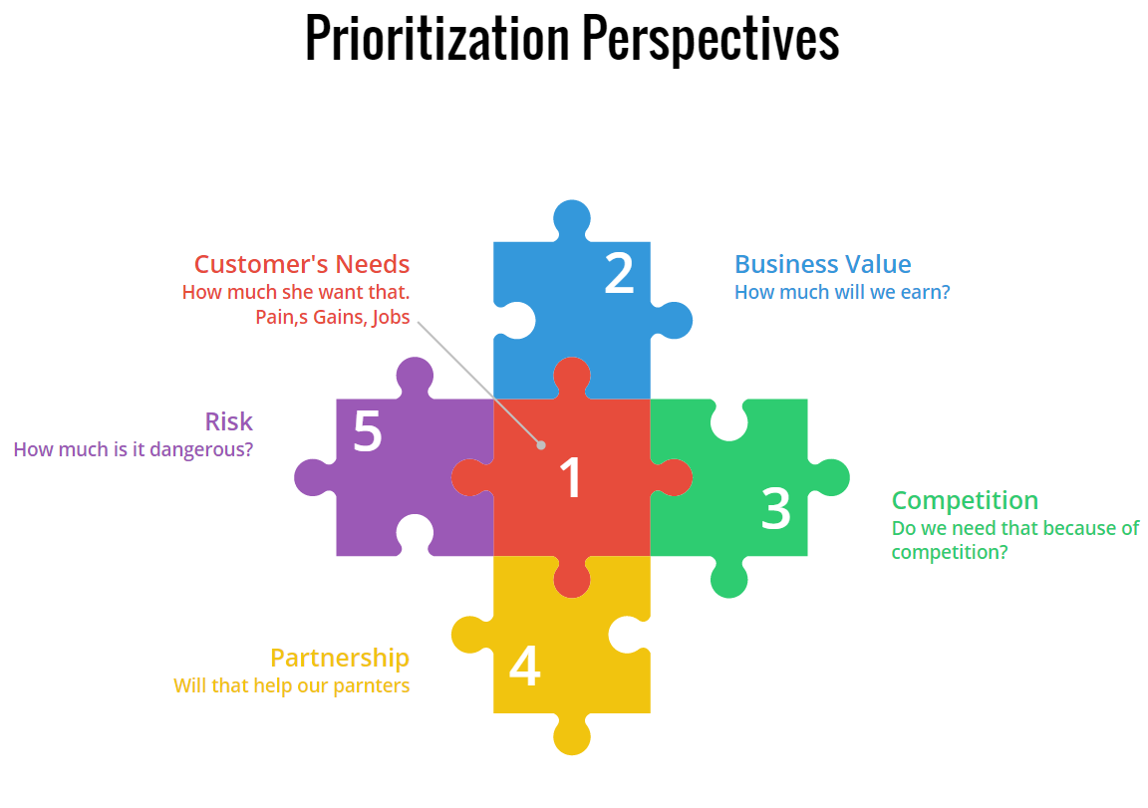
Customers’ perspective
In ScrumDesk we prefer to consider the customer’s perspective first. The idea is that a satisfied customer is a driver of further changes and success of the product itself . A satisfied customer is willing to improve the product not just by social marketing, by new ideas, but in our case even by the development of the product itself.
As the product owner, the first thing you have to understand is who your customer/user is. You need to understand and describe her space, her context, her jobs, the pains or gains she is looking for.
The best part is just coming. Based on a more than 10 years old survey done by Scot Ambler, 45% of functionalities are NEVER, NOT ONCE, used. Only 7% are used always. Plus 13% very often.
So, why develop something that customers will not use? You just spent the life of your colleagues! Common! The answer is NO! Now MoSCoW prioritization comes to help.

Based on that you should be able to decide if a feature is:
- Must – a heart is a “must”. Without it, there is no live organism. What is a must in your application?
- Should – a hand is “should”. Without it is hard. But you can survive even without a hand. Well, in most cases.
- Could – hair is “could”. It is fine to have them, you even look nicer, but you will definitely survive without them
- Won’t – unnecessary waste. Btw, is there anything “won’t” in a body?
How to estimate MoSCoW values in 7 steps?
- As a Product Owner, try to be in the skin of your customer. There might be multiple types of them, so choose one, or some group of them.
- If you were him, will the feature be a must, should, could, or won’t?
- Forget about the time of development, forget about effort. It is just about customer and feature.
- What if this feature was not a must, but should? Would the customer realize that?
- What if the feature was could and not should? Would the customer realize that?
- Try to make it less “must”. Remember 7% features used always.
- Compare requirements to each other. Repeat a couple of times.
Let’s say your backlog looks like this:
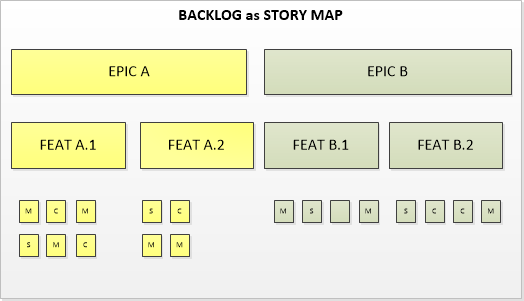
After MoSCoW prioritization you should have a line of requirements ordered by MUST, SHOULD, COULD values. This might be done in ScrumDesk PLAN view

How to manage MoSCoW in ScrumDesk ?
To set the value to backlog item you need just click it (in any view, either STORY MAP , BACKLOG , PLAN or WORK ) to access details in the side view. Prioritization fields are displayed below the title of the backlog item. The first one is MoSCoW.
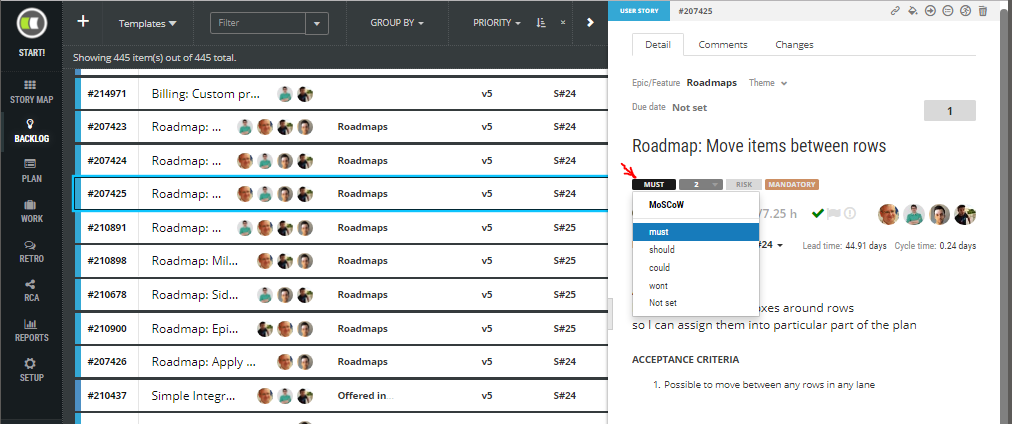
Value can be visible on cards in STORY MAP.
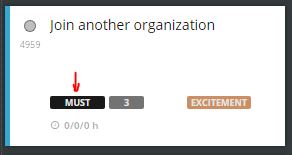
Once the value is entered, you can filter and group items based on it all ScrumDesk views, i.e. in the product backlog.
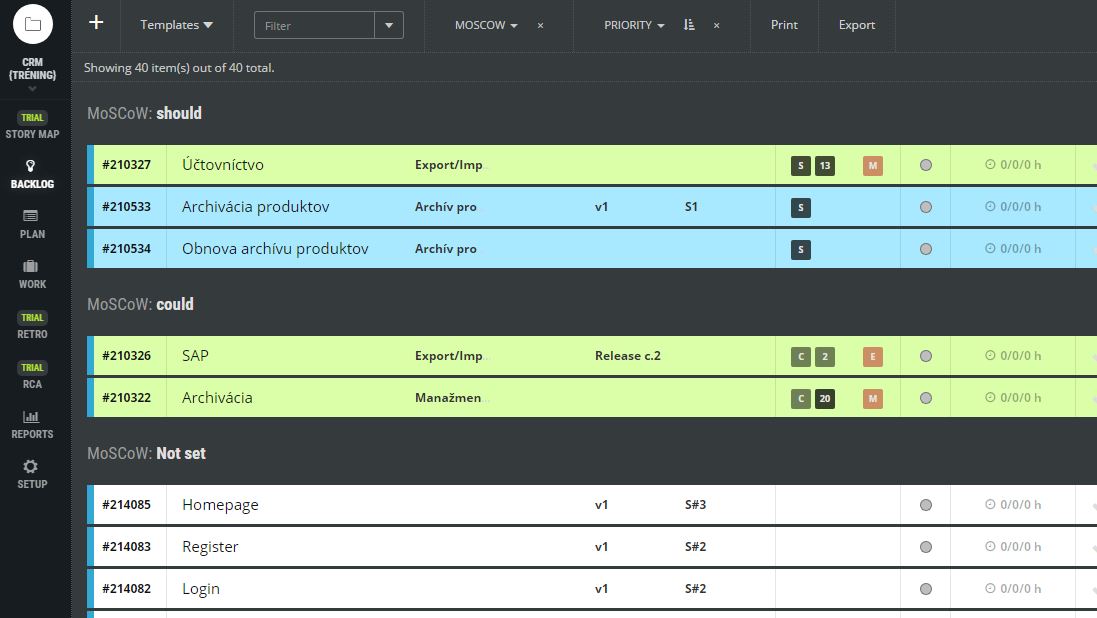
However, you are not done with prioritization in this step. What about business value? More to follow…
< Print physical cards | Content | Agile prioritization based on Business value >

- Business Decision Makers
- Dynamics 365 Sales
New Microsoft Dynamics 365 and Microsoft Copilot innovations for supply chain, sales, and service join the 2024 release wave 1
- By Bryan Goode, Corporate Vice President, Business Applications and Platform
- Dynamics 365 Supply Chain Management
- Microsoft Copilot for Sales
Sellers, service agents, and supply chain professionals share a common goal: delivering quality goods and services to customers on time, every time. Today, we are announcing new experiences for Microsoft Dynamics 365 that help professionals across business functions to collaboratively solve challenges, streamline workflows, and focus on what matters most—key factors for transformative customer experiences. These new products and capabilities join hundreds of other features launching between April and September as part of the 2024 release wave 1 .
Innovations announced include:
- New AI demand planning capabilities in Microsoft Dynamics 365 Supply Chain Management Premium, a new product offering that’s now available.
- New AI-powered insights and actionable recommendations to improve operational processes and deliver exceptional customer experiences, from sales to service.
- Updates to Microsoft Copilot for Sales and Microsoft Copilot for Service, extending Microsoft Copilot for Microsoft 365 with role-specific insights and actions that integrate with your existing contact center, customer relationship management (CRM) systems, and productivity apps.
New AI capabilities with Dynamics 365 Supply Chain Management Premium
In October 2023, we announced the public preview of new demand planning capabilities for Dynamics 365 Supply Chain Management. These capabilities are available today in a new product offering, Dynamics 365 Supply Chain Management Premium. The new demand planning capabilities create a more flexible, simplified, and intuitive user experience. By combining insights with streamlined collaboration, planners can have an increased level of trust for a more reliable forecast. Customers like Poloplast , an Austrian pipe manufacturer, is using Dynamics 365 to enhance its demand planning and forecasting.
“The storage space allocation of our goods has improved because it is now based on statistical methods surfaced in Dynamics 365 … . We have seen a measurable reduction in external storage costs as a result, significantly less than what we used to require.” Holger Kreisel: Head of Enterprise Resource Planning, Poloplast
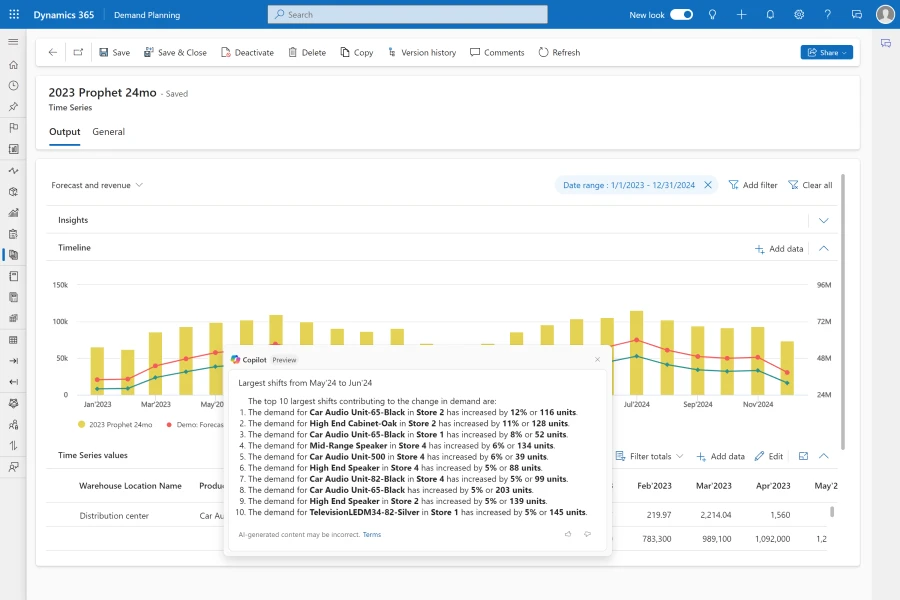
With general availability, we are also adding several new capabilities that significantly enhance demand planning. Users can engage with Copilot-provided data insights that bring a new level of intelligence and automation to demand forecasting, and allowing for more accurate and data-driven decision-making. The new product phase-in-phase-out process helps support smoother transitions in product life cycles, minimizing disruptions and optimizing inventory levels. The introduction of row-level security enhances data protection, allowing for granular access control and safeguarding of sensitive information. Moreover, the new cell-level commenting feature complements the existing plan-level commenting, providing users with the flexibility to annotate specific data points. This fosters a more detailed and collaborative planning process, where insights and context can be shared directly within the demand planning workspace.
New AI capabilities help boost seller productivity and close deals faster
Microsoft Dynamics 365 Sales continues to bring new capabilities that extend customer insights and boost sales through intelligence, collaborative selling, and Copilot-enhanced sales processes. A new proposal summary feature recaps important details within lengthy customer proposals associated with a specific contact, opportunity, lead, or account. The summary briefs sellers on the budget, authority (decision maker), need and timeline gleaned from the proposal or agreement documents, and recommends next best steps.
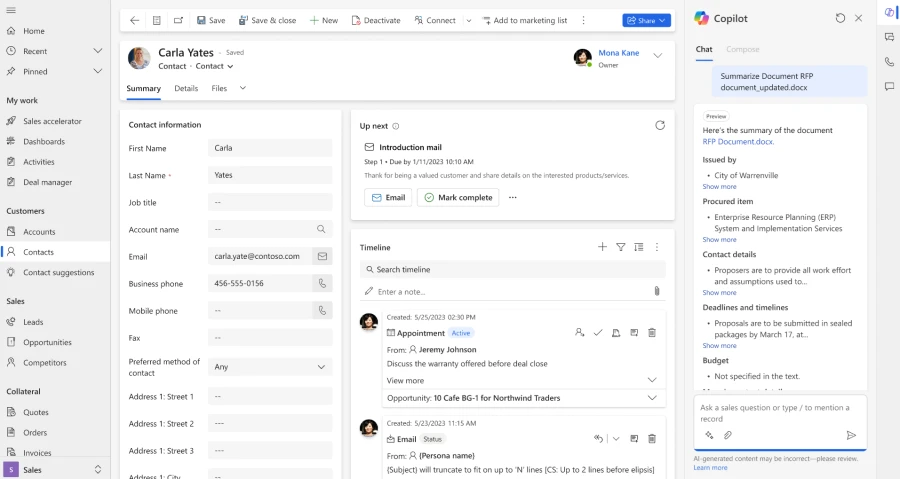
Additionally, sellers can access enhanced AI-powered insights and actionable recommendations in the flow of work, including in the immersive Copilot homepage, helping them stay on top of active customer email conversations and post-meeting actions to move deals forward faster.

New lead qualification enhancements enable sellers to assign opportunities to the right seller, view an AI-generated lead qualification summary, and create multiple opportunities from a single lead. These features will be available in public preview in mid-May 2024.
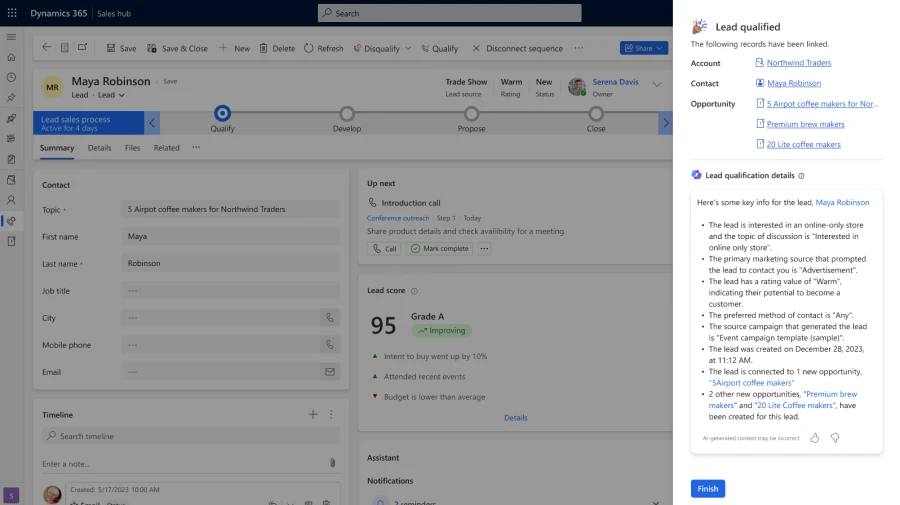
Microsoft Copilot for Sales introduces new generative AI capabilities that enable sellers to access sales-specific skills, data, and actions from within Microsoft 365 applications like Outlook and Microsoft Teams. With the new conversation intelligence platform, managers can measure and guide their sellers’ activities without physically shadowing them. Sales managers can use this dashboard to coach sellers to improve their sales interactions, understand customers and analyze market trends, and get insights which will help you build a sales strategy. You can download the public preview here , available since March 15.
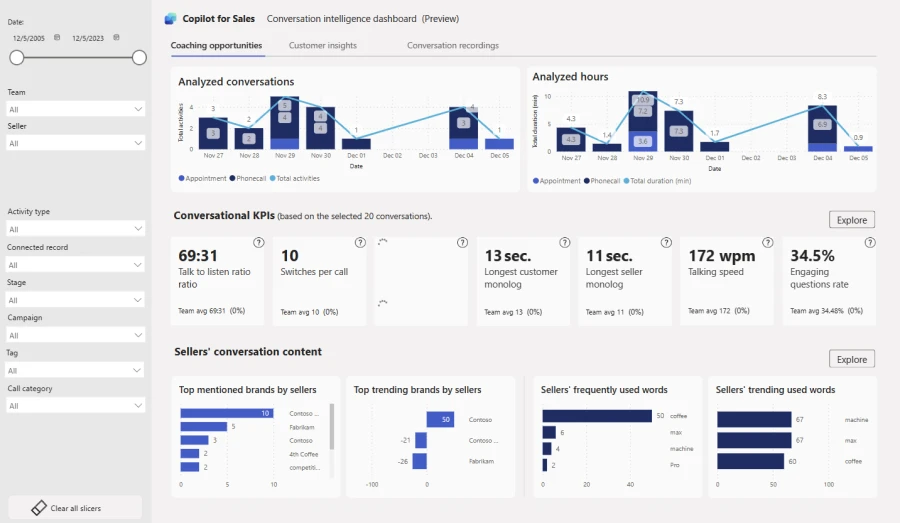
Activity orchestration across various accounts and activities is one of the biggest challenges for sellers. When sellers work in a collaboration space in Teams, Copilot will monitor conversations and suggest tasks based on the selling team’s activities. Once accepted, the tasks are automatically generated with assigned owners. Sellers can add a tab in the collaboration space to access and view the status of tasks assigned to team members. This capability will be generally available in mid-April 2024.
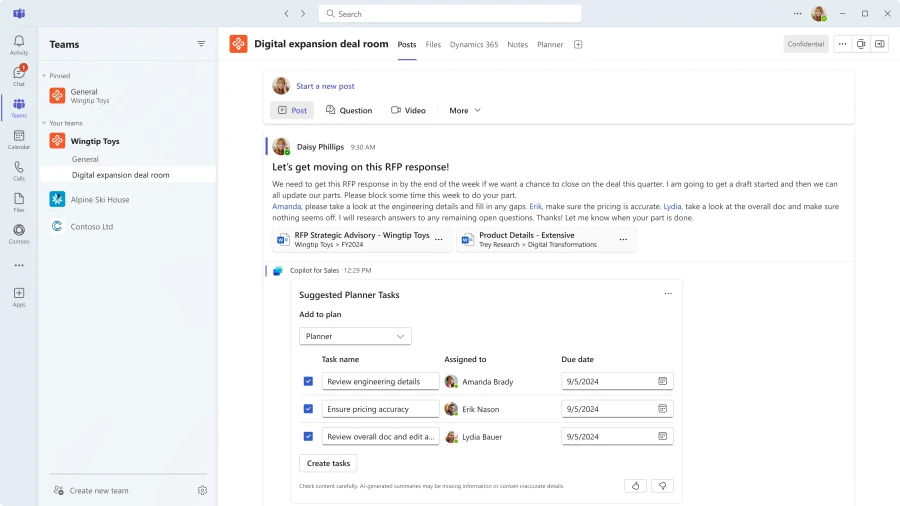
New AI innovations continue to boost agent productivity and deliver personalized experiences
Microsoft Dynamics 365 Customer Service continues to deliver innovations that empower agents to accelerate case resolution and provide exceptional customer experiences. Agents can now get a succinct overview of the most recent and significant updates related to any record in the Dynamics 365 timeline, and swiftly catch up in just a single click. Copilot generates the streamlined timeline highlights , summarizing key developments from various activities, such as those in emails, notes, and conversations, enhancing agent productivity by minimizing unnecessary clicks and lengthy scrolling. This helps agents to have faster and clearer interactions with customers to meet their expectations.
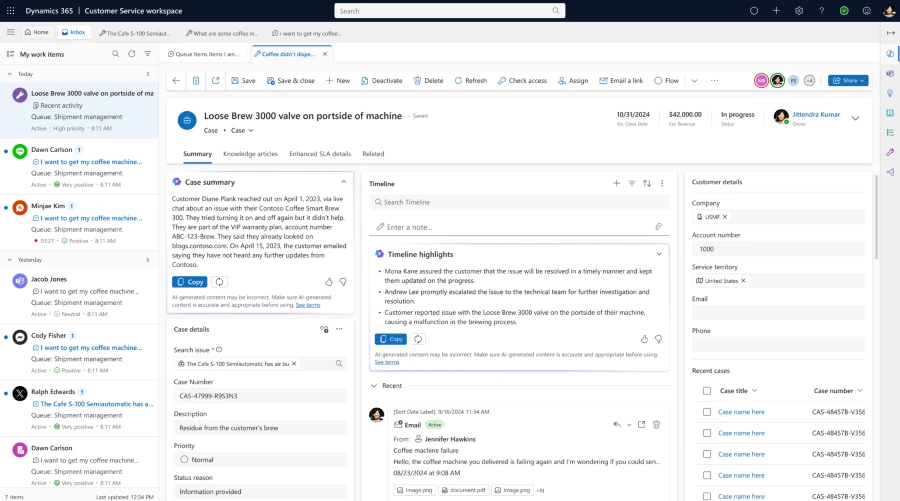
Agents can also conveniently use Copilot inline right within the email editor, in addition to the side panel, to generate contextual draft email responses. They can refine their existing drafts with follow-up custom prompts and single-clicks, using Copilot without requiring any knowledge articles. Together, these enhancements make navigation in the workspace more flexible and deliver an easier email authoring experience. The capabilities will be generally available in North America this month with a subsequent planned rollout for other regions.

In addition to currently supported knowledge sources such as Microsoft SharePoint, Copilot can now be extended to access customer, product or case data in Microsoft Dataverse , with prompt plug-in support. Agents can get a unified experience using these plug-ins, as they no longer need to switch to other tabs and tools to connect to information residing in Microsoft Dataverse. Agents save time as well, as Copilot can automatically identify the right prompt plug-in needed, based on the question being asked and through a deep understanding of the intent implied by the question. Available in public preview later this month, support for prompt plug-ins created in Microsoft Copilot Studio helps agents deliver faster resolution and increased customer satisfaction.
AI innovations in Dynamics 365 Customer Service omnichannel capabilities also significantly uplevel self-service automation, redirecting more cases that would be typically escalated to an agent. Customers can engage with a robust conversational AI driven experience, with IVR enhancements that now include fine-tuning speech for optimized authoring, improved speech recognition accuracy, and an overall better customer experience when dealing with interrupts, latencies, and information collection.
Additionally, Copilot for Service features previously available in preview status will reach general availability later this month. These include the ability to use Copilot in Outlook and Teams to summarize and draft emails, access case summaries, browse and update CRM records, and more. Download the Copilot for Service app to experience Copilot for Service in Teams and Outlook.
In May, we will introduce in preview the ability for agents to ask Copilot for answers to questions about CRM data—such as case, contact, or knowledge details, as well as use Copilot to summarize case details.
Be sure to explore the detailed release plans for Dynamics 365 and Microsoft Power Platform and keep track of what’s new and upcoming, as well as create a personalized release plan, in the release planner .

Business Applications Launch Event
Learn about new features and capabilities for Dynamics 365 and Microsoft Power Platform.
Watch the virtual Microsoft Business Applications Launch Event
Tune in to the Business Applications Launch Event this Wednesday, April 10, at 9 AM Pacific Time for more details and demos of new capabilities across Dynamics 365 and Microsoft Power Platform. In addition, you can explore several special topic presentations covering the evolution of generative AI, including small language models and AI experiences to help transform strategic, cross-domain business problems.

Related posts

2024 release wave 1 kicks off with hundreds of AI-powered capabilities for Microsoft Dynamics 365 and Microsoft Power Platform

Revolutionizing marketing workflows with Copilot in Dynamics 365 Customer Insights

Forrester TEI study shows 315% ROI when modernizing customer service with Microsoft Dynamics 365 Customer Service

Explore the next wave of AI innovation at the Microsoft Business Applications Launch Event

IMAGES
VIDEO
COMMENTS
MARKETING MANAGEMENT - MKTG 611 FALL 2016 5 COURSE SCHEDULE Session & Date Topic & Preparation Questions Reading Assignment (from Marketing Math Essentials) Session 1: 8/31/2016 (Wednesday) Introduction, Analyzing Markets & Customers (I) This class discusses the role of marketing in the firm. It focuses on the importance of segmenting the market
Advertising simply put is telling and selling the product. Advertising Management though is a complex process of employing various media to sell a product or service. This process begins quite early from the marketing research and encompasses the media campaigns that help sell the product. Without an effective advertising management process in ...
Setting goals for your advertisement assignment will help you measure its success and guide your design choices. Common advertising goals include: Increasing brand awareness. Driving website traffic. Generating leads or sales. Encouraging customer engagement.
2. Active Listening. The skill of active listening allows Advertising Managers to truly hear and integrate feedback from clients, consumers, and their own team. This leads to more effective communication, stronger relationships, and campaigns that better align with the target audience's needs and preferences.
Synthesis Assignment. Each student may hand in an individual assignment that answers the following question: "What are the three most important lessons that you learned about marketing in this course that will help you as a manager?" This assignment should be no more than one page in length and should briefly summarize each of the three ...
Advertising management helps bring and introduce new business solutions to the market. In addition to boosting brand awareness, it gives you a platform to show your advantages over the competitors, and it also opens up brand-new markets for your business. 2. Keeps advertising under control.
In this advertising management assignment, we will be focusing on the Virgin Airline and its advertising management concentrating on perpetual mapping, consumer insight analysis, and ad analysis. Advertising is an effective way of communication and it manages the variety of services of the Virgin Company. Connecting with the customers and ...
An Advertising Manager is a strategic professional who spearheads the promotion of products, services, or brands through various advertising channels and campaigns. Tasked with the crucial role of driving brand awareness and sales, they blend creativity with analytical insights to craft compelling advertising strategies that resonate with ...
Gathering real life examples to use throughout your assignment is essential for a number of reasons: 1 - Expands your knowledge. 2 - Provides insights into what other organisations are doing ...
4: Marketing Strategy. Expand/collapse global location. 4.23: Assignment- Marketing Plan, Part I. Page ID. Lumen Learning. Lumen Learning. Student Instructions: Complete the following information about the organization and products and/or services you will focus on as you develop a complete marketing plan throughout the course.
Students will learn persuasive techniques used in advertising, specifically, pathos or emotion, logos or logic, ... Look for ads that lend themselves well to the assignment, with a balance of text and images and with fairly discernable examples of pathos, logos, and ethos. Consider asking your school library media specialist for issues of ...
In simple terms, digital marketing relates to promotion and advertisement of certain ideas and services via electronic means. While it's mostly related to Internet technologies, digital marketing also covers mobile phones, digital street banners, online intellectual property protection, and anything where electronic platforms are used.
It will be a group exercise. Instructions will be provided. A report will be due on the Monday following the final class session. Assignments section includes information about some general cases, group case reports, along with a list questions based on the case study topics to guide the report. It also includes individual case reports and a ...
The Advertising Management though is a complex process of employing various media to sell a product or service. This process begins quite early from the marketing research and encompasses the media campaigns that help sell the product. Without an effective advertising management process in place, the media campaigns are not that fruitful and ...
This page should include at least one recommended action in addition to the careful diagnosis of the firms' marketing strategy and tactics. The addition pages should address each of the 4 P's, any of the 5 C's that you feel are relevant, and the general marketing strategy of the firm. Your emphasis on the 4 P's (and 5 C's) can vary ...
MARKETING MANAGEMENT ASSIGNMENT.docx - Free download as Word Doc (.doc / .docx), PDF File (.pdf), Text File (.txt) or read online for free. Scribd is the world's largest social reading and publishing site.
PUTRAJAYA CAMPUS SEMESTER 1 2019/2020 MARKETING MANAGEMENT INDIVIDUAL ASSIGNMENT MARKETING MANAGEMENT MKTM613 PREPARED BY: NUR SYAKIRIN SULAMIN (SB22937) PREPARED FOR: ASSC. PROF. DR. RUSINAH BT SIRON 1 TABLE OF CONTENT No. Content Page No. 1 Question 1 3-4 2 Question 2 5-7 3 Question 3 8-9 4 Question 4 10 - 13 5 Question 5 14 - 16 6 Question 6 17 7 References 18 - 20 2 QUESTION 1 Explain how ...
Strategic Marketing Management - BUSI 520 CG • Section 8WK • 11/08/2019 to 04/16/2020 • Modified 09/05/2023 Apply Now Request Info Course Description This course is designed to provide the ...
Management document from The Hong Kong Polytechnic University, 13 pages, Assignment 2 FAN Zhanhao 23105891g 1.P&G Selling Soap a. For each of the three products in turn, use the spreadsheet "Profit_Gambit.xlsx"to determine how much the total advertising cost would change if the required minimum increase in the sales of that pr
Liberty University Weekly MMIP Questions BUSI520-B Hannah Maritz January 31, 2021. Week 2 MMIP Introduction Hulu is a service that streams all your favorite shows like How I Met Your Mother to movies like Dead Poets Society. The platform made itself a fierce competitor to other streaming services like Netflix and Disney+ by offering services the others can't provide.
assignment_turned_in SEDeC experience ... In February 2015, we launched the Strategy Sessions project, whereby the senior and middle management of the university, as well as lecturers, were given the opportunity to train with top Russian experts in education and academia. ... including advertising content, information letters and newsletters ...
Registration assignment_turned_in +7 495 539 3003 [email protected] +7 495 539 3003 [email protected]. ... Moscow School of Management SKOLKOVO, Professor of Business Practice, Ex Board Member, Vice President and Head of Human Resources Department at Sistema JSFC ... including advertising content, information letters and newsletters, invitations ...
American University and other top M.B.A. programs are reorienting courses around artificial intelligence. "It has eaten our world."
DESIGN & REKLAMA 20 th Exhibition of Advertising Industry APRIL 15-18, 2014, Moscow, CHA. DESIGN & REKLAMA, the largest exhibition of the advertising industry, will take place in Moscow on April 15 th - 18 th , 2014. Patrons: Moscow City Government Slideshow 4731310 by lamont
Sales performance management (SPM) is a process that helps sales organizations track, manage, and improve the work of their sales teams. This includes everything from forecasting to implementing training programs, monitoring activities, quota management, and incentive planning. SPM focuses on guiding sales reps toward achieving company goals.
To set the value to backlog item you need just click it (in any view, either STORY MAP, BACKLOG, PLAN or WORK) to access details in the side view. Prioritization fields are displayed below the title of the backlog item. The first one is MoSCoW. Value can be visible on cards in STORY MAP. Once the value is entered, you can filter and group items ...
Watch the virtual Microsoft Business Applications Launch Event. Tune in to the Business Applications Launch Event this Wednesday, April 10, at 9 AM Pacific Time for more details and demos of new capabilities across Dynamics 365 and Microsoft Power Platform. In addition, you can explore several special topic presentations covering the evolution of generative AI, including small language models ...